
The Daily Telegraph Garden, at the 2014
Chelsea Flower Show. This is just a portion of the elegant space designed by Tommaso del Buono and Paul Gazerwitz. Tommaso grew up in Florence, and Paul in New York, and together they have an international practice, based in Shoreditch, East London. Here, a giant panel of Nocino Travertine Limestone punctuates a tall, green hedge. Low topiaries, pruned into pincushion shapes, flank a bench that floats in front of the limestone.
Late July 2014.
September of 2008: As I was displaying my garden furniture in a rather grotty convention hall in Birmingham, England, I was invited by a representative of the Royal Horticultural Society to exhibit my designs at their next Chelsea Flower Show. And so, in May of 2009, I found myself and my creations arranged in an elegant tent, on the grounds that surround Christopher Wren’s Royal Hospital, in London. I’d made it to Biggest Gardening Extravaganza on Earth. With that invitation to be part of the Show, my life changed, but not in the obvious ways. Certainly, I was honored to have my furniture recognized: when the Trade Stand Manager first settled herself onto one of my hand-crafted, wrought iron and steel chairs, she exclaimed “there’s nothing else in the World like what you design! I’d like you to come our Show next year.”
But what my nine days as an Exhibitor then really began — as I witnessed the hard labor and significant sleight of hand that went into assembling the nearly-instant Show Gardens at Chelsea, and later on began to learn about what the judges of the Royal Horticultural Society deemed prize-worthy — was a train of thought about the purposes and methods of creating ornamental gardens…one that has consumed me ever since, and which has compelled me to delve deeper and deeper into the huge inventory of REAL gardens that grace England’s landscape.
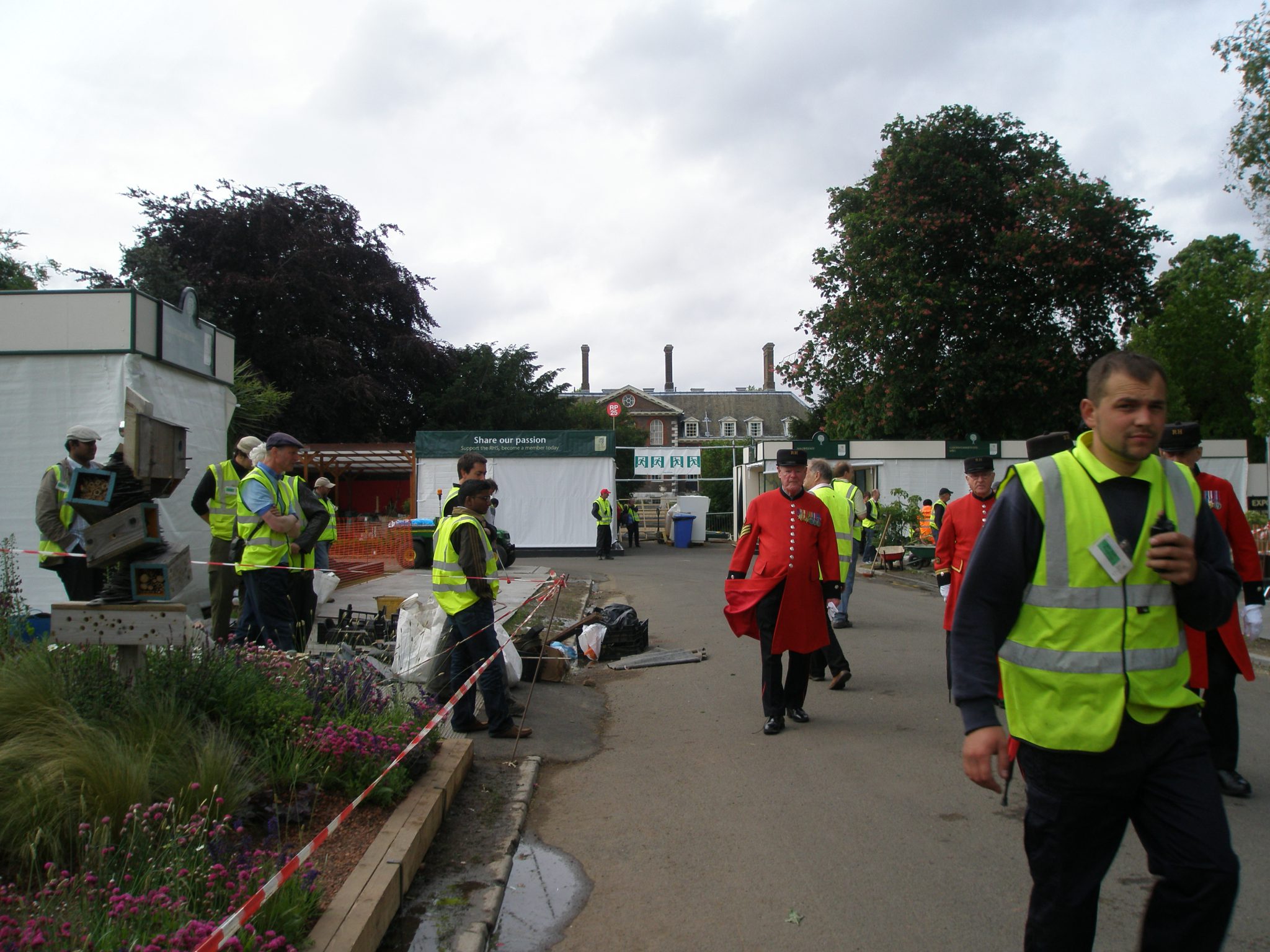
What I saw, behind the scenes. This was Main Avenue, where the major Show Gardens are, on May 17, 2009…just two days before Press Day at that year’s Flower Show. One could never imagine that this Avenue would shortly boast large gardens which looked mature and permanent.
When one visits the Chelsea Flower Show — held each May, as it has been for 101 years — the hope is always to see the most ingeniously designed and most impeccably planted examples of the gardener’s art. The Chelsea Flower Show also can serve as a master class in fads, techniques, and horticulture. On May 21st of this year, I accompanied my dear friends, Anne and David Guy, to the Flower Show. (For a look at Anne Guy’s garden designs, follow this link
www.anneguygardendesigns.co.uk .)
Per usual, when I’m with Anne and David, part of the Show’s entertainment-value comes from comparing notes about our favorite displays, and, more entertainingly, kvetching about our LEAST favorite Show Gardens. Yes, every Show-Goer becomes a Critic! This article will be the third that I’ve written about Chelsea. In the summer of 2009, I described my experience as an Exhibitor, for New York Social Diary. Two summers later, yet another NYSD article appeared about that year’s Show (If, after you’ve finished this article, you’re not totally gardened-out, you can read my 2011 report by following this link. www.nysocialdiary.com/node/1906745 )
Being fortunate enough to see the workings of the Show, from the different perspectives of Exhibitor, and later of Spectator, and also to have photographed and analyzed a succession of Chelsea Flower Shows, has caused my attitudes about the Show to evolve. Here now, my report on the most recent Spectacle, held in Chelsea, on the banks of the Thames.
The first order of business for a stay in London’s Chelsea neighborhood is to secure a comfortable perch. As I’ve done for the past six years, I perched at the Sloane Square Hotel ( www.sloanesquarehotel.co.uk ) ,
a place that has become my home away from home, whenever I’m in London. The Hotel is on the north side of the Square, and the best of London’s museums, historic buildings, parks, shops and river-scapes are all either close at hand or within healthy-strolling distances. An Underground station is nearby, and the Square also has two taxi stands, so nabbing a cab is never a problem…as can often be, in many other parts of the city.

The Sloane Square Hotel’s location, high calibre staff, very fine breakfast menu, low-keyed but elegant decor, and extremely comfortable beds and bedding make me forget all of the discomforts that can come after long weeks away from home, and instead make me feel utterly serene, well-rested and expertly cared for. Photo courtesy of Sloane Square Hotel.

This is the Club Room I always request, for my sojourns at the Sloane Square Hotel. Photo courtesy Sloane Square Hotel.
Fine cafes and restaurants abound in Sloane Square. For refueling at various times of day, my favorites are these: Cote Brasserie (within the Sloane Square Hotel) for breakfast; the Top Floor Cafe at the Peter Jones Department Store (diagonally across the Square from the Hotel) for late-morning coffee; Coco Maya (on the pedestrian-only stretch of Pavilion Road) for early-afternoon lunch; and Gallery Mess, or Manicomio (both on Duke of York Square), for dinner. Good Traveling MUST be accompanied by Good Feeding.

The Peerless Morning View over Southwest London, from my table at the Top Floor Café, in the Peter Jones Department Store, on May 19th. More soon, about the architecture of this Store.
www.johnlewis.com/our-shops/peter-jones

Coco Maya, on the southernmost end of Pavilion Road, offers home-made salads and sandwiches, quiches, and goodies. They also serve the best pots of tea in London.
www.cocomaya.co.uk/our-stores
The most delightful surprises for a Visitor to Sloane Square during Chelsea Flower Show week come from the flower-bedecked storefronts. For the past nine years, local merchants, with the blessing of the Royal Horticultural Society, have transformed their street-scapes with flowers, as they’ve sought Gold (aka, First Prize) in the Chelsea in Bloom competition. The sidewalks come alive with color and fragrance….and often also with a pure and very-welcome exuberance which the garden designers at the nearby Chelsea Flower Show either do not—or cannot—allow themselves. All in all, this neighborhood celebration can be less stressful and more joyful than visiting the Flower Show itself. Even better, the storefront displays of Chelsea in Bloom are free for all to admire…unlike the Show, for which tickets are scarce, and costly.
Here’s a ramble ‘round the streets near Sloane Square, with a look at some of the most charming floral concoctions. I always enjoy watching the assembly of those displays, and so this picture album will begin with peeks at the delightful and eccentric presentations of two next-door neighbors on Pavilion Road: Basia Zarzycka, and Moyses Stevens. Basia hand-crafts life-like silk flowers, along with nearly-over-the-top wedding tiaras (many of which I’ve purchased over the years….that would be her flowers… NOT her tiaras, because getting married just once was enough for me), and Moyses Stevens stocks some of the most beautiful REAL flowers in all of London.
On the morning of Monday, May 19th, I lingered on Pavilion Road, as a posse of florists worked their magic in front of these two shops…
Now, for a look at some other finished displays, in and around Sloane Square.

Rag & Bone, which is located at one corner of the Sloane Square Hotel’s block, presented a much simpler display in 2014 than their 2013 entry in the Chelsea in Bloom competition…which had won them a Gold.

And a gorgeously-filled Sloane Street window box. Note one of London’s omni-present cranes, looming in the background.
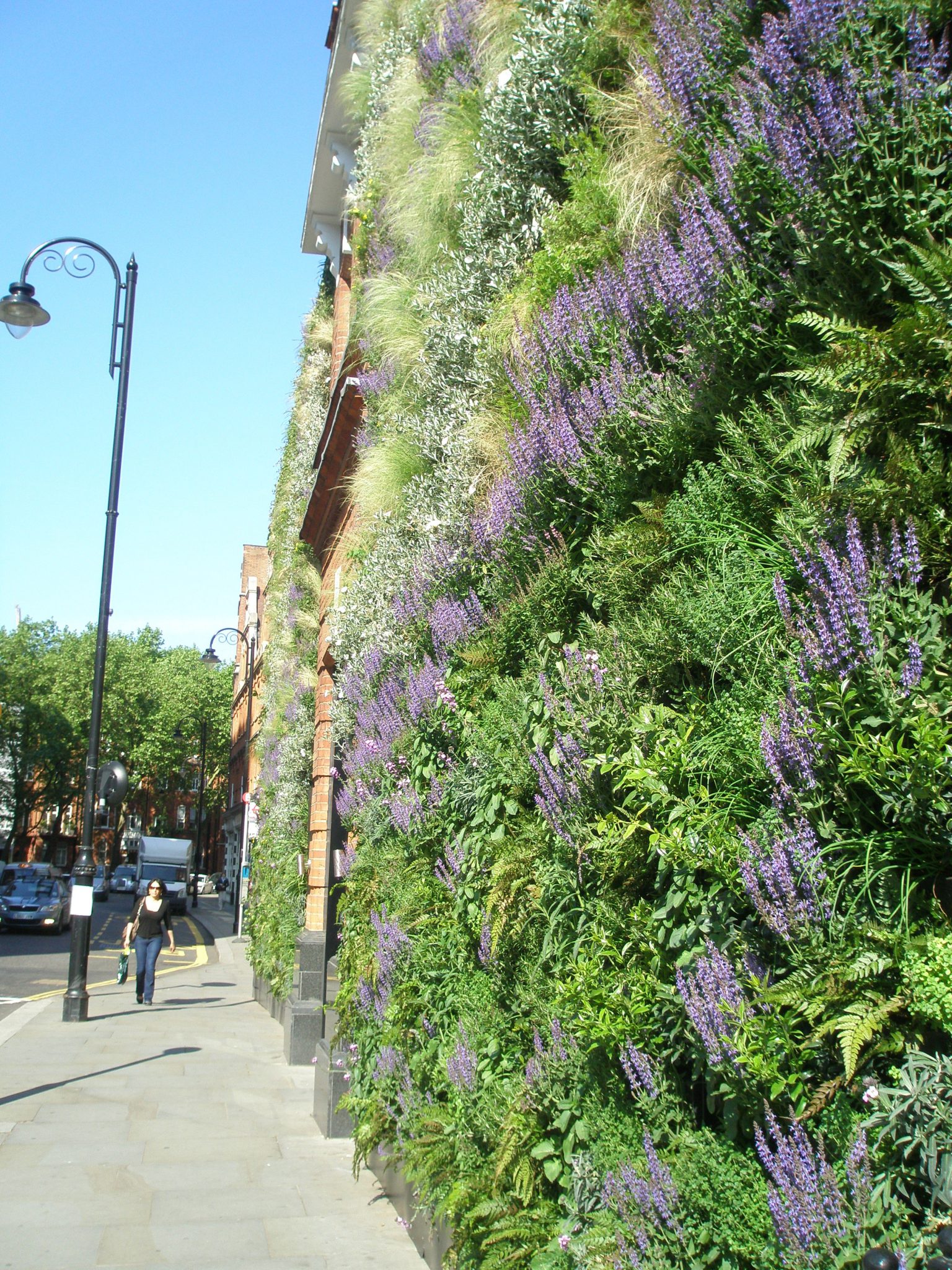
A towering Green Wall, on Symons Street, which is directly across from the Peter Jones Department Store. I watched this wall being assembled and now understand that such vertical gardens are neither simple to plant, nor easy to maintain.
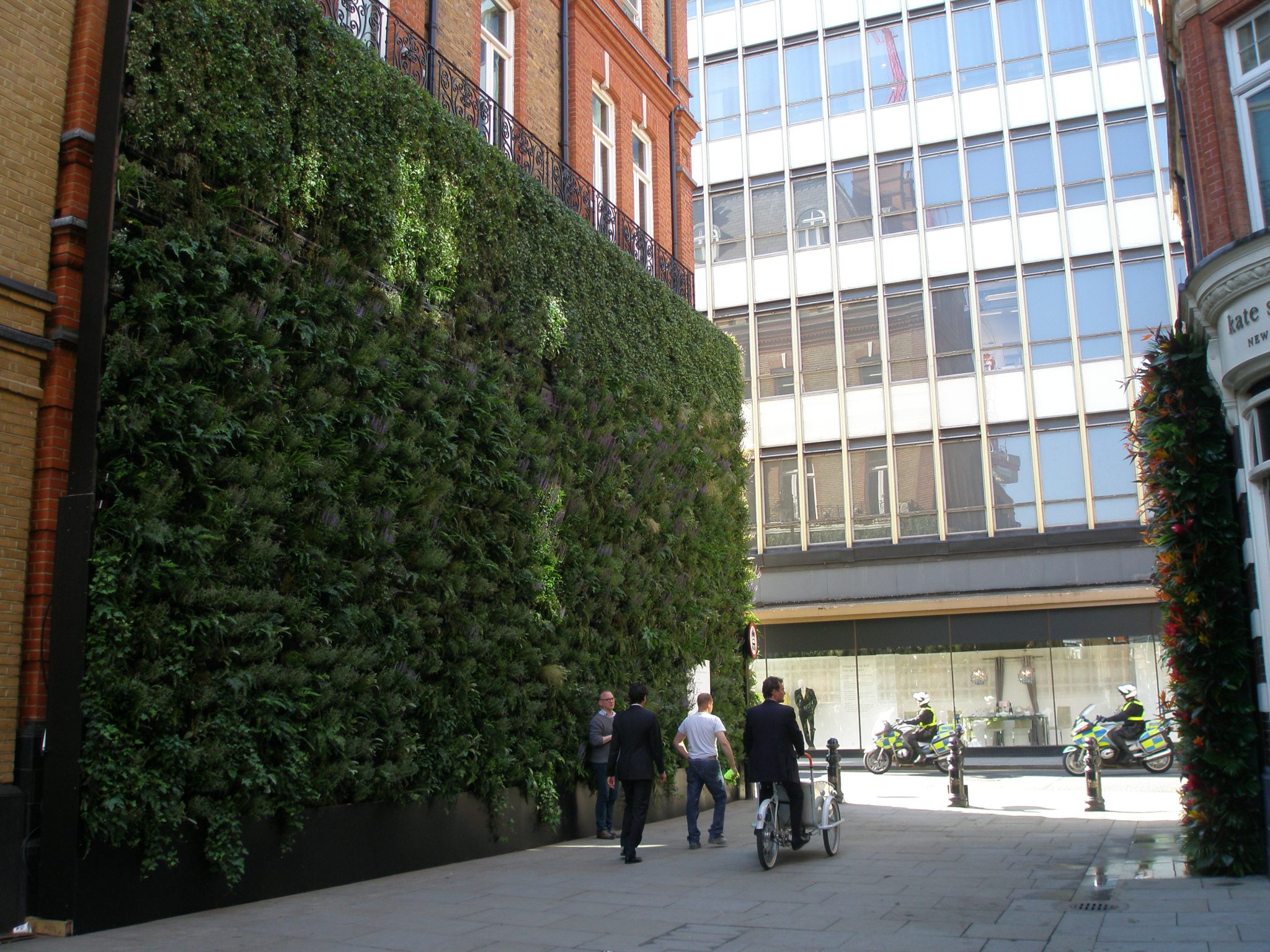
The Green Wall continued around the corner, to the pedestrian mall on Pavilion Road. The Symons Street elevation of the Peter Jones Department Store is visible at the end of the mall.
The Peter Jones Department Store, which was constructed in 1936—1938, is one of the finest buildings of that decade. As Jones & Woodward’s GUIDE TO THE ARCHTECTURE OF LONDON states, this is “a rare example of a modern building solving the complex problem of relating both to existing street and square frontages, and to a corner. Although it was not London’s first curtain wall, the façade remains one of its finest examples.”

An early-morning view of the Peter Jones Department Store, from my windows at the Sloane Square Hotel. I took this photo on August 21, 2013.
To continue with the GUIDE TO THE ARCHITECTURE OF LONDON, ”The top floor is set back, like an ocean liner. The interior has a large, glazed spiral staircase. In the 1960s, a splendid seven-storey interior atrium was created. “ The Top Floor Café that I recommend for morning coffee provides two spectacular views: one, down into the atrium; the other, out over the rooftops of Chelsea.”

Now, back to year 2014. Here, a less-towering living wall, this one at Kate Spade on Pavilion Road, which is directly opposite the Green Wall. The Royal Horticultural Society awarded the 2014 Chelsea In Bloom GOLD to this exuberant and exotic display.

On Duke of York Square, the Liz Earle display, to which the RHS awarded their Silver (aka 2nd Prize), for Chelsea in Bloom. I wasn’t inspired by this presentation…
Onward, to the Main Event: my day-long visit to the Chelsea Flower Show, on May 21, 2014. I hope these photos will make you feel that you too were there with us in London on a cloudy and cool-ish Wednesday.

Anne and David Guy and I approach the entry gates, which are on the grounds of the Royal Hospital at Chelsea. It’s early, and the densely-packed crowds haven’t yet materialized…this will soon change.

We pause now for a Reality Check. This is what the same area at the Royal Hospital looks like when there’s no Hullabaloo happening. I took this photo on August 23, 2013, during my previous visit to London.

Five Days that Shape the Gardening Year? We shall see…
Image courtesy of the RHS Chelsea Flower Show catalogue.
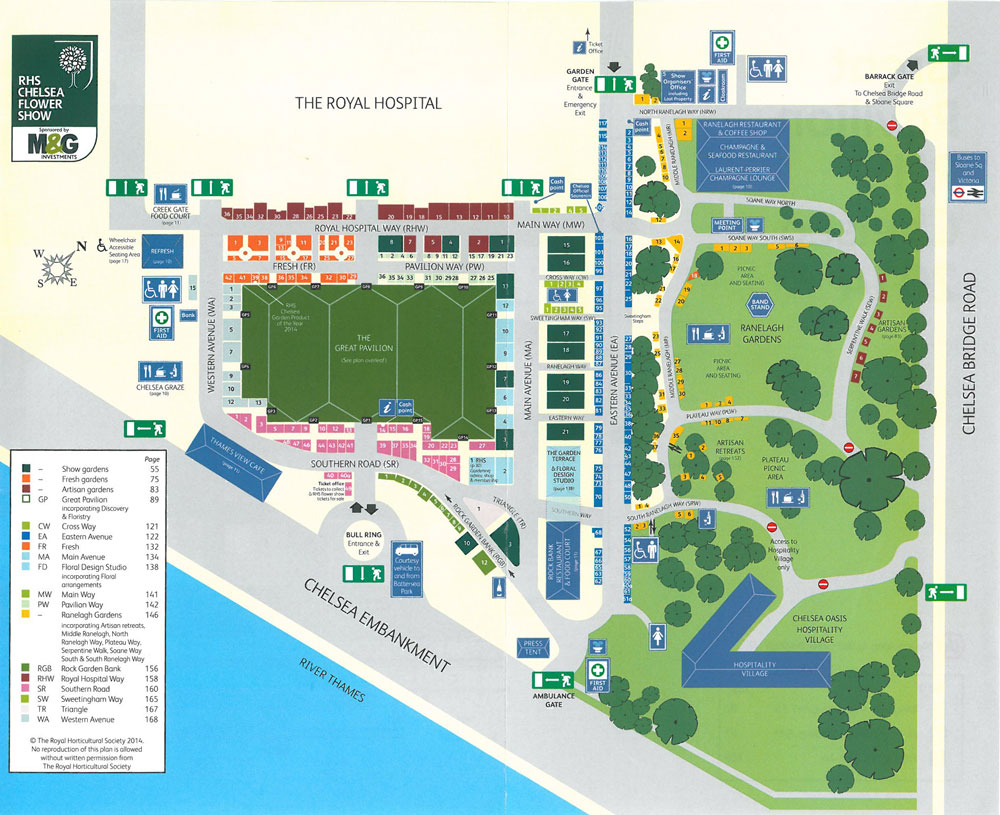
Plan of the grounds at the Chelsea Flower Show. Image courtesy of the RHS Chelsea Flower Show catalogue.
First, a survey of the Show Gardens, in the order that we encountered them. Bobbing and weaving through the crowds at the Show is an art, one which I’ve learned from observing the quiet, no-body-contact way in which Anne Guy sidles her way through the press of people at the ropes which separate Spectators from Show Gardens. Taking photos at the Show is NOT easy. For every tranquil-looking image you see here, there’s been quite a bit of waiting and maneuvering done beforehand.
To introduce each of the Show Gardens, I’ll begin with a page taken from the Catalogue. It’s always interesting to compare the Designers’ drawings–and their various manifestos—with the actual gardens.

The M&G Garden. M&G has generously sponsored the Chelsea Flower Show for the past five years. Image courtesy of the RHS Chelsea Flower Show catalogue.

The M&G Garden. Don’t imagine that you too could explore this garden. Mere mortals cannot venture inside: one must be a member of the Press, an RHS official, or a Friend to gain entry.
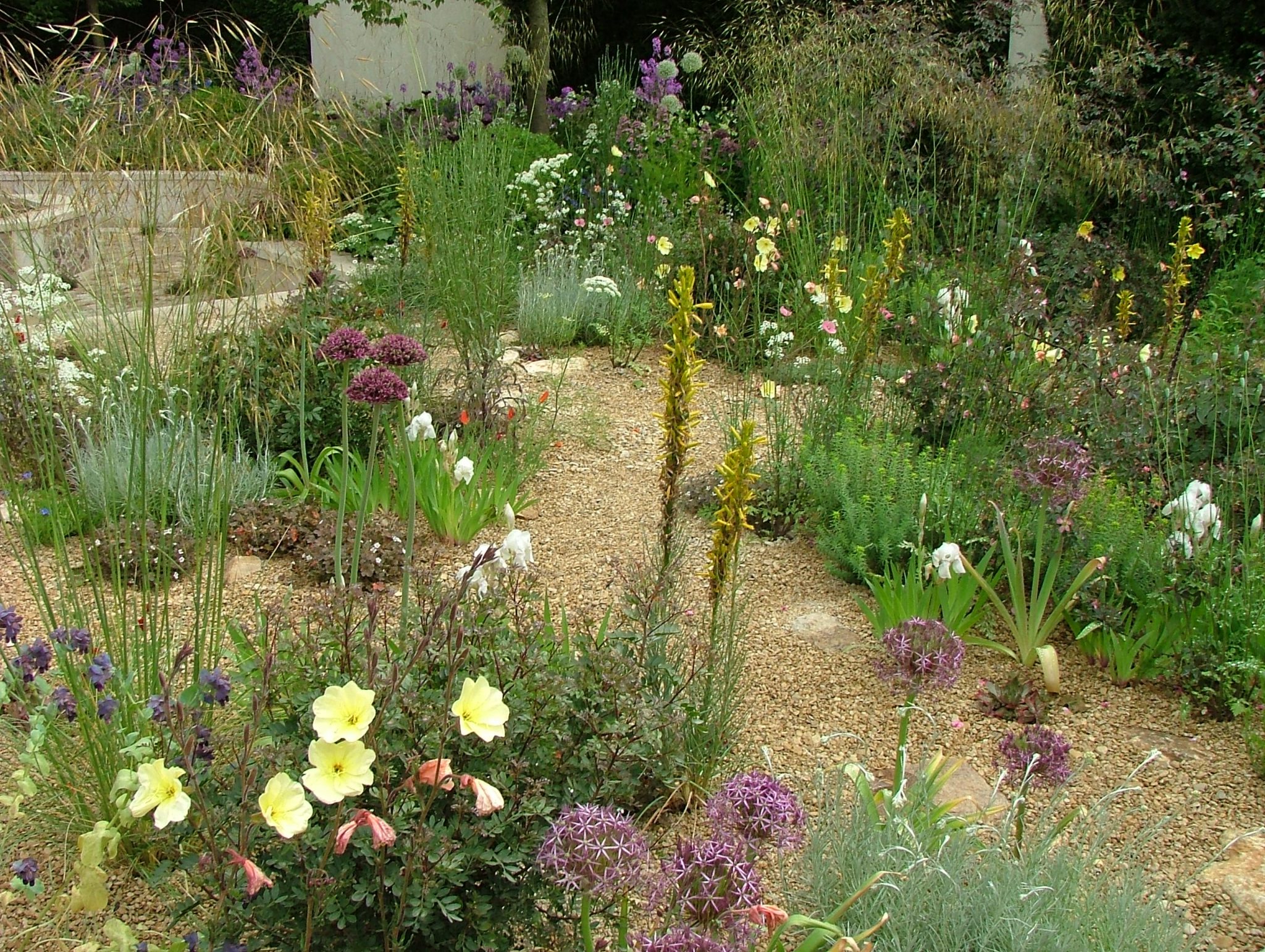
The M&G Garden. This garden’s plantings seem almost scattershot. I enjoy pleasant chaos in a garden as much as anyone, but the plantings here need a bit more focus. Photo by Anne Guy.

Another Reality Check!
Peering back in time: during my August 23, 2013 visit to the grounds at the Royal Hospital. This is the exact site upon which the 2014 M&G Show Garden would be built, 8 months later.

The Brand Alley Garden. This is the absolutely KINDEST angle I could devise, for photographing this garden.

A Throng…alongside one edge of the Brand Alley Garden. In front of them: a murky expanse of water, where more garden plots should have been. Using so much precious square footage for this uninviting pool seems sheer design laziness.

Another view of the Brand Alley Garden, with its unwholesome-looking pool. If the water had been made clear, and into a home for aquatic plants and some happy koi, and the pool then punctuated with some stepping stones, this view could have been much nicer. And the screamingly-red pavilion should have been painted in a muted shade…something which suggested the patina of time. My head spins that so much money and effort was spent to create such a mediocre garden.

The Telegraph Garden. Nope…I won’t be coy. This is my favorite Show Garden….utterly inviting and serene, while also stimulating to the eye. A gorgeous blend of classical and modern design. I want one!

Tommaso del Buono, and Paul Gazerwitz, designers of the Telegraph Garden. The RHS wisely awarded these gentlemen a Gold Medal. Photo courtesy of The Telegraph.

The Laurent-Perrier Garden. Given a Gold Medal, and also declared by the RHS to be the Best Show Garden of 2014.
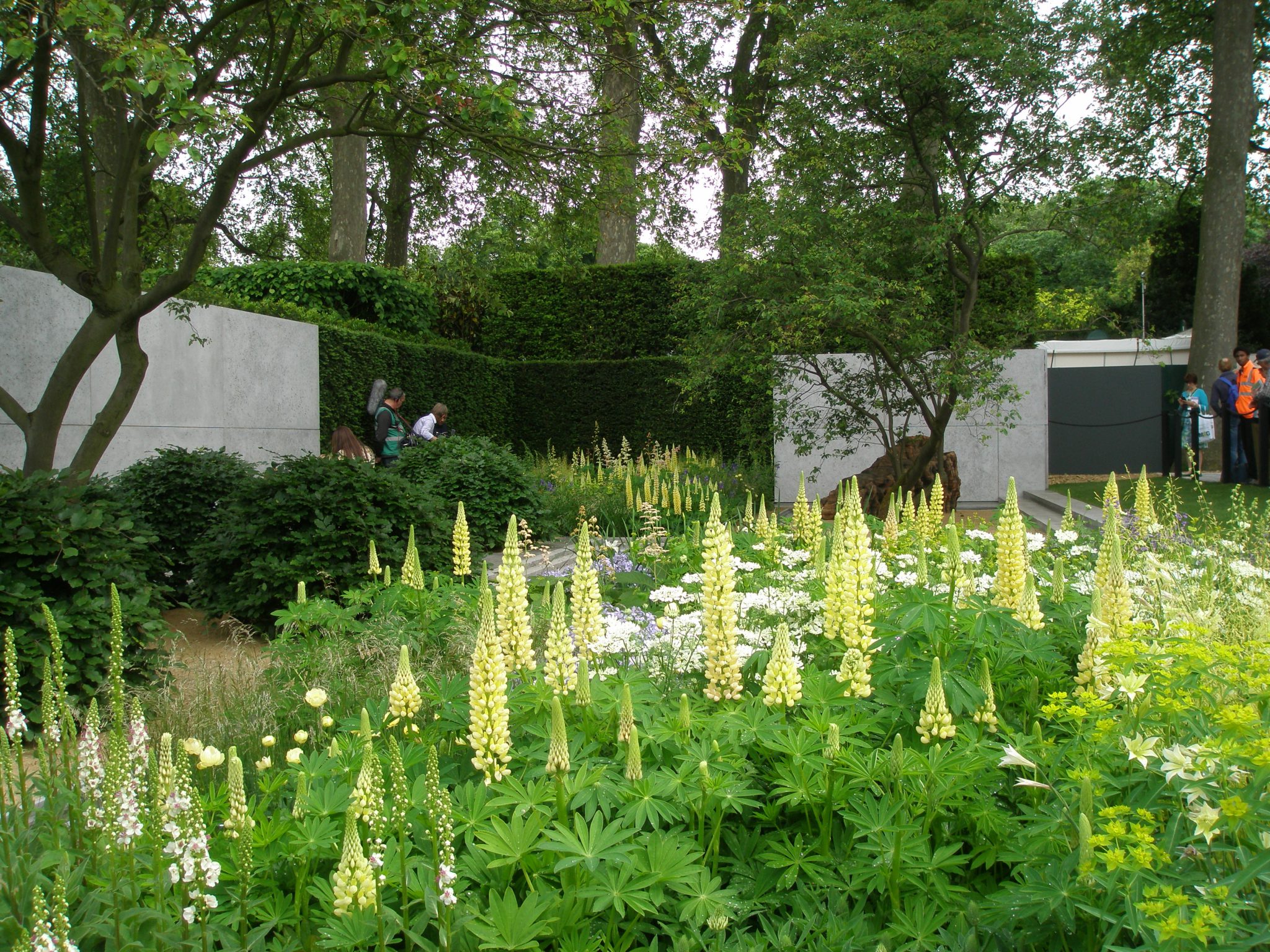
The Laurent-Perrier Garden. While I admire this elegant space, the garden nevertheless seems stiff, and doesn’t make one long to settle down there, for an afternoon dawdle. Too much precision can suck the joy out of a garden, and the horticultural uniformity shown here seems almost timid, rather than refined.

The Laurent-Perrier Garden. Once again, I stress that this is a Most Admirable Garden….but somehow my admiration cannot transform itself into love.

The Laurent-Perrier Garden. Perhaps the stern gray color of the stone here in the pool is what makes me want to keep my distance from this carefully-crafted garden.

The Brewin Dolphin Garden. What’s wrong with this picture, you ask? This garden demonstrates a worrying trend in Chelsea Show Gardens. Tall trees are planted along the edges, which makes it nearly impossible for Spectators to peer inside. The designer has fashioned a garden which can only be experienced by the BBC film crews, and RHS judges. This is Bad Show Garden Design…no matter WHAT the RHS thinks.

No Man’s Land: ABF The Soldiers’ Charity Garden. Image courtesy of the RHS Chelsea Flower Show catalogue.

Here’s the illustration of No Man’s Land, provided by the Designer. This was yet another nearly-impossible to see, much less photograph, garden. The leafy trees at the outer perimeters, and the tall grasses on the mound to the rear of the garden, kept most of the interior features invisible. Although admirable in its intent (and appreciated by the RHS, who awarded a Gold Medal), if a garden cannot be fully SEEN by a normal Show-Goer, I cannot consider that garden to be a success.

Positively Stoke-on-Trent. There’s an awful lot going on in this garden….certainly too much! But the audaciousness and vigor of the display made for fun viewing.

Cloudy Bay Sensory Garden. To me…this is only mildly appealing spot in the garden. Photo by Anne Guy.

The Extending Space. Note the partially-submerged “stepping stones.” This is a beautiful and intriguing detail. Photo by Anne Guy.

RBC Waterscape Garden. This garden has too many elements: water, densely planted areas, intricate poured concrete gullies, rusted metal walkways…the cooks had good ingredients, but threw too many of their spices into the pot.

Vital Earth The Night Sky. Here again is a garden which cannot be fully-viewed by people who must remain behind the ropes. It becomes increasingly difficult not to be impatient with Show Gardens where plantings obscure interior details.
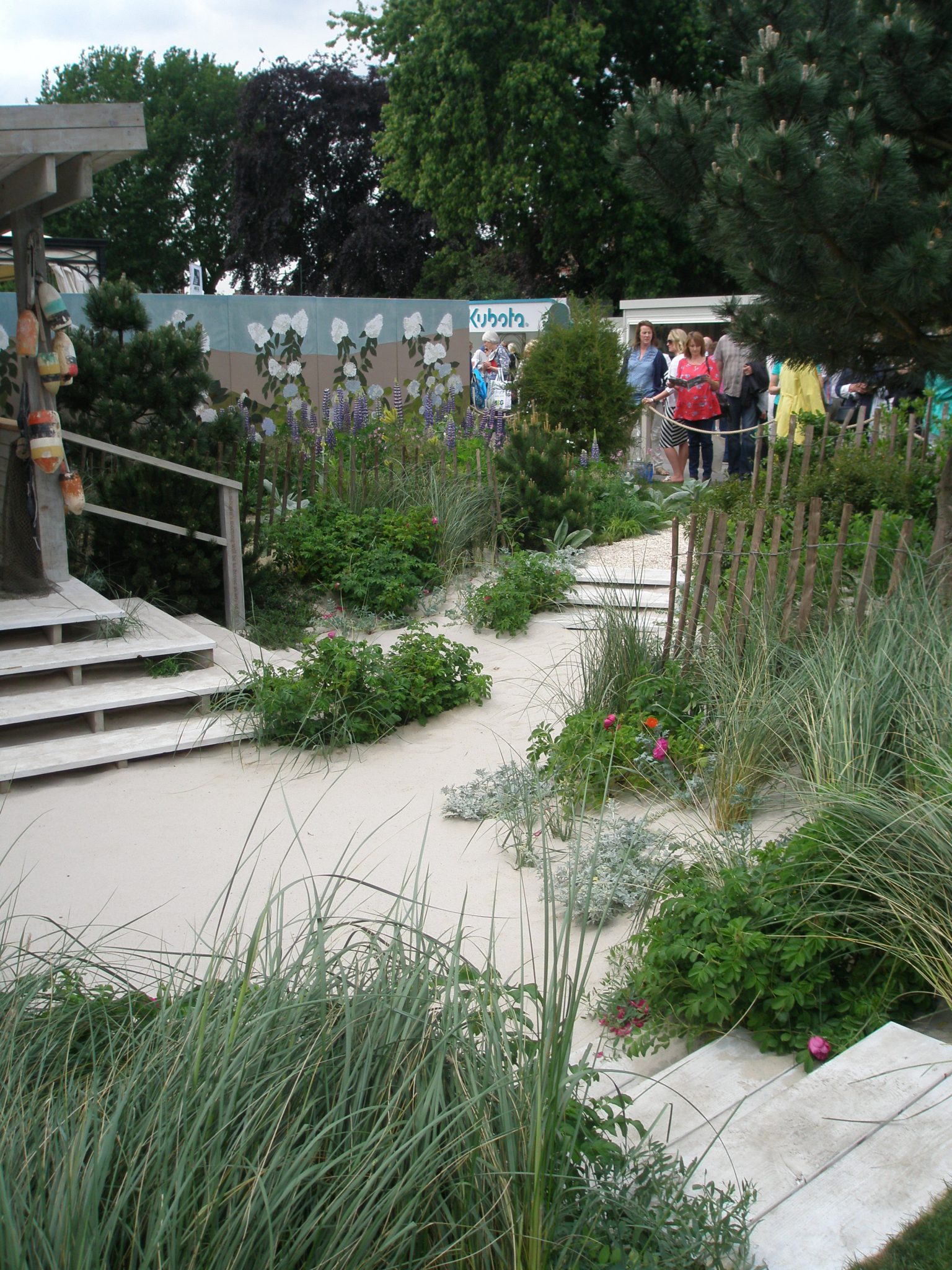
The Massachusetts Garden. The backdrop of leather, appliquéd flowers is utterly awful, and thus distracts from the rest of the garden. As a proud New Englander, I’d hoped for better from my Massachusetts neighbors. Groan….

Hope on the Horizon. Winner of the People’s Choice Award, in the separate competition run by the BBC.
Done with our surveys of the Show Gardens, we threaded our way through the crowds toward the Artisan Gardens, which are arrayed along the eastern edge of Ranelagh Gardens. But first, we passed the RHS’s own contribution to the Show Garden area, titled “From the Moors to the Sea.” This garden was made to mark the 50th anniversary of their Britain in Bloom program, along with their colleague Alan Titchmarsh’s 50 years in horticulture.
After “From the Moors to the Sea,” we crossed Eastern Avenue, which is the Main Retail Drag of the Flower Show. The press of Humanity there had achieved a daunting density, which would be maintained for the remainder our day. Truly, Chelsea isn’t for the easily-exhausted, or faint-hearted.

Another Reality Check. Here’s a reminder of what Eastern Avenue looks like, during tranquil times. I took this photo on August 23, 2013.

Now: back to May Madness in 2014. Here’s the Humble Garden Glove, elevated to new, artistic heights at a stall on Eastern Avenue.
We arrived at Serpentine Walk, where we craned our necks to catch glimpses of the Artisan Gardens. Here’s how the Royal Horticultural Society explains
their Artisan Garden category: “The Artisan Gardens engage visitors with their artistic and naturalistic approach. These small plots are crafted with incredible workmanship, maintaining traditional skills, and enhancing the beautiful surroundings of Ranelagh Gardens.”

Will it be possible to see anything at all of the Artisan Gardens? That’s the Dial A Flight Potter’s Garden, behind the Mob.
At #7 Serpentine Walk: The Topiarist Garden at West Green House. Designed by Marylyn Abbot.
At #6 Serpentine Walk: Togenkyo—A Paradise on Earth. Designed by Kazuyuki Ishihara. The RHS gave this garden a Gold Medal, and also named it Best Artisan Garden, and justifiably. The exquisitely detailed space, which seems to occupy a far larger area than its small footprint, can teach a careful observer a lifetime’s worth of gardening techniques.
At #5 Serpentine Walk: 75 years of the Roof Gardens in Kensington, designed by David Lewis (which apparently made NO impression whatsoever upon me, thus my Lack of photographic record!).
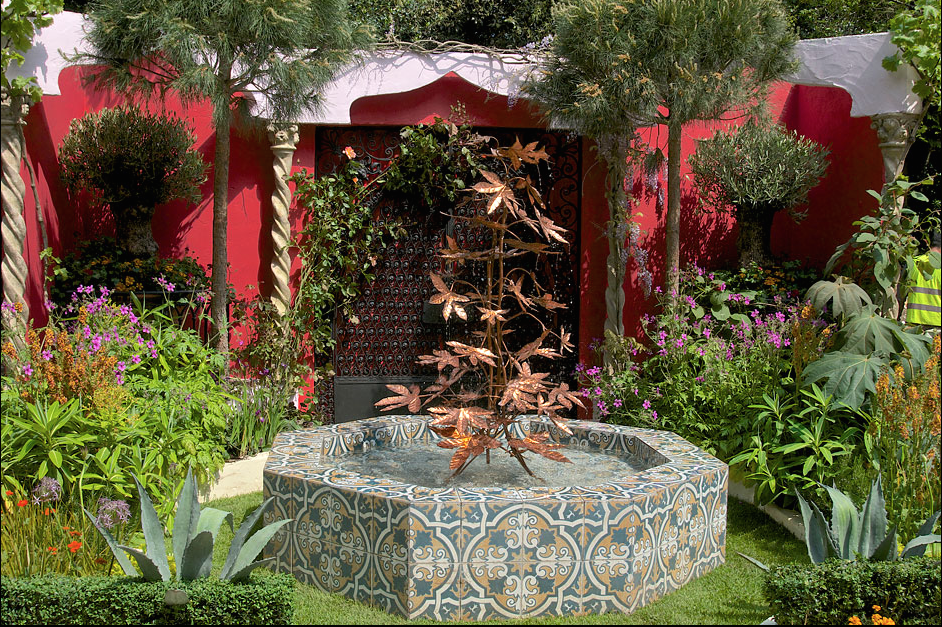
75 Years of the Roof Gardens at Kensington. YIKES…now that I see this display, my eyes are screaming:”Too Much Here, Crammed Into Too Little Space!” Photo courtesy of the RHS.

75 Years of the Roof Gardens at Kensington. At least Anne Guy was alert enough to take this single photo of the garden.
At #4 Serpentine Walk: Tour de Yorkshire. Designed by Alistair W. Baldwin.
Alongside RHS Judgment-Passing, the BBC conducts its own Peoples’ Choice Survey. Tour de Yorkshire won Best Artisan Garden, in that populist contest.

Tour de Yorkshire. The rear wall of this garden is partially composed of reclaimed bicycle wheels, sourced from recycling centers in Yorkshire.
At #3 Serpentine Walk: Arita. Designed by Shuko Noda.
At #2 Serpentine Walk: The Dial A Flight Potter’s Garden. Designed by Nature Redesigned.

Potter’s Garden. Note: the Artisan Gardens all sit on plots measuring 5 meters by 4 meters. Photo by Anne Guy.
And at #1 Serpentine Walk: The Viking Cruises Norse Garden. Designed by Sadie May Stowell.
Worming our way through the crowds at the Artisan Gardens had made us very hungry…time to get some lunch. We walked past the Ranleagh Gardens
Bandstand: an oddly sedate audience sat there while a band did some serious rocking-out (perhaps mostly only Old Farts who don’t dance…or tap their toes… attend the Flower Show?).
Our attention was riveted by an enormous, upside-down packing crate, which we later learned was one of the entries in the recently-established
Fresh Gardens category of small Show Gardens. The RHS describes the Fresh Gardens as: “Welcoming new ideas and the latest in contemporary materials and design. Innovative, unusual, informative and sometimes challenging, the Fresh Gardens are the cutting-edge face of the RHS Chelsea Flower Show.”

It’s an Upside-Down-World in the “The World Vision Garden,” which was designed by John Warland. The plants which seem to be growing up out of the floor are actually reflections of pots, which are suspended from the ceiling.
Little did we know that, after enjoying The World Vision Garden, the rest of the Fresh Gardens (which were all clustered on Royal Hospital Way, next to the Great Pavilion) would prove to be disappointing…. but you’ll eventually get to decide if you agree with me, in a bit.
We lunched in Plateau Picnic Area, where the food trucks were serving surprisingly good grub, along with gallons upon gallons upon gallons of Pimm’s Cup (a gin-based potation, with orange and cucumber slices thrown in as garnish).
Revived by our meals, ‘twas time to for us to get to the Heart of the Horticultural Matter — otherwise known as The Great Pavilion—which the RHS calls: “The centerpiece of the Chelsea Flower Show. The Great Pavilion is a horticultural haven of stunning floral displays from the UK and around the world, complemented by floristry and informative scientific exhibits.” When Elizabeth II makes her annual visits to the Chelsea Flower Show, she takes a fast trot through the major Show Gardens, but then spends the lion’s share of her time in the Great Pavilion, where the folks with dirt under their fingernails—the ones who actually GROW things— explain their work.

HM The Queen, in 2013, during a fast tour of a Show Garden. Image courtesy of the RHS Chelsea Flower Show catalogue.

Yet another Reality Check. This was my view, on August 23, 2013, of the area at the Royal Hospital where the Great Pavilion and the Show Gardens are erected, every May. The obelisk on the lawn serves as the central point, in the Flower Show’s Great Pavilion.

Here’s that same obelisk, now become the Center, in the Great Pavilion…way back when, on May 17th, 2009.

Map of the Exhibitors in the Great Pavilion, at the 2014 Chelsea Flower Show. Image courtesy of the RHS Chelsea Flower Show catalogue.
Years now of Chelsea-going have taught me that there’s no systematic way of touring the Great Pavilion, where displays are organized on a grid which is separated by many, too-narrow, grass walkways…which eventually turn into mud. The point is to keep progressing along any path where movement is possible; but sometimes foot traffic grinds to a halt…especially when folks gather to gawk at the various and competing displays of towering delphiniums. The Great Pavilion is a Slow-Motion-World of BIG and BRIGHT and MORE!
Here, a record of my random prowling through the Great Pavilion.

Impeccably-grown plants, nicely displayed at the Daisy Roots stand. This grower specializes in choice and unusual perennials and grasses. Their address: Jenningsbury, London Road, Hertford. SG14 3LG,
England. Phone# 07958-563355

See that lady, with the Big Yawn, in the background? This is what I felt like, at Hour Five of our Chelsea visit.

What you see here are just a fraction of hundreds of Amaryllis, which were hung upside down from the ceiling.Photo by Anne Guy.

This spic-n-span, cartoon-version of a WWI trench, used as a setting for flowers, seems misguided. Image courtesy of the RHS.

This sums up the aesthetic of the Great Pavilions’ displays. The RHS gave this a Gold. Image courtesy of the RHS
Done with the Great Pavilion (or, in my case, Brain-Scrambled-and-Generally Done-In–By… ), we ambled outside toward Royal Hospital Way, in search of an energy-boost, which we soon found in the form of strong tea, accompanied by warm scones and clotted cream. One last mission remained: we needed to explore the Fresh Gardens area. But I was distracted by our view of the central portion of Christopher Wren’s Royal Hospital, which loomed ahead… serene and unbothered by the nearby Flower-show Fray.
Since I’m never one to forego an opportunity to inflict a little architecture-history-lesson, let’s pause for a moment, with another excerpt from the GUIDE TO THE ARCHITECTURE OF LONDON. Christopher Wren’s Royal Hospital was built from 1681—1691. His colleagues on the project were Nicholas Hawksmoor, (of whom I’m a Great Fan) and John Vanbrugh.
“The hospital was established to house army veterans [note: as it does, to this day], imitating Louis XIV’s building of Les Invalides.”

The Chelsea Pensioners are always the jolliest attendees, at the Flower Show. I took this picture on May 17, 2009, during a build-up day at the Show, prior to its opening. Here, Pensioners and construction workers say “Cheese!”
“It gave Wren one of his largest secular jobs, and while the planning is that of the traditional closed squares or Oxford colleges, the courts are open, the largest looking outwards to the river [Note: Or, during the Chelsea Flower Show, looking outwards toward the Great Pavilion]. The style, in brick, is more Dutch than French, although each façade is equipped with a triple-height Tuscan portico or centerpiece in stone. King Charles II and Christopher Wren provided a model for institutional and collegiate architecture which has proved workable for three centuries in all the English-speaking countries.”
Perhaps the clarity and elegance of Wren’s buildings had made it impossible for my eyes and brain to then adjust to the visual chaos and intellectual confusion of the nine, small-scale Fresh Gardens that were arrayed nearby. Reassessing one’s assumptions about what good design is—or what good taste is, for that matter– is always invigorating, but these Fresh Garden entries seemed all to be trying too hard (I’ll spare you, and will not quote the various statements-of-intent which accompanied each garden). The Fresh Gardens left me with the feeling that what I’d seen had been mostly sophomoric attempts to explore gardening’s new frontiers. However—on the positive side: the general absence at the 2014 Chelsea Flower Show of what the RHS advertised as the “cutting-edge face” of gardening means that a Fresh Face or Two may indeed appear, in future years. Here’s hoping….
I’ll (mostly) let these pictures speak for themselves.

The Mind’s Eye. Designed by LDC Design, for the Royal National Institute of Blind People. The RHS gave this a Gold Medal, along with its award for Best Fresh Garden. The BBC People’s Choice contest also named this Best Fresh Garden.

The Mind’s Eye. Try as I might, I simply cannot see this as anything other than a combination elevator/shower. The entire space, which the designers describe as “a sensory garden for blind and partially sighted people…a journey of discovery, memory and imagination,” seems unreasonable and hazardous.

City of London Corporation Oak Processionary Moth Garden. Designed by Helen Elks-Smith, for the City of London. Image courtesy of the RHS.

Himalayan Rock Garden. Designed by Janey Auchincloss and James Soane for Global Paving. Image courtesy of the RHS.
Now, back to that Train of Thought about the purposes of ornamental gardens, and the methods of creating them. Whether or not the Chelsea Flower Show in any given year seems edifying or entertaining, seeing these massively costly and nearly-instant-gardens causes anyone who loves gardens to wonder if the designs that pop up from the earth around the Royal Hospital every May are either representative of the realities of British garden-making, or harbingers of the fashions to come.
In early July, Tim Richardson, who is arguably the most accomplished garden writer in England, published his post-mortem about the 2014 Chelsea Flower Show. Here are the most salient points of his article, which he titled “GOING FOR GOLD LEAVES GARDEN DESIGN IN A RATHER DULL STATE. WHERE IS THE VERVE?”
“The widespread perception among visitors to the Chelsea Flower Show this year was that it was once again afflicted by ‘samey-ness,’ with the planting in the main show gardens appearing to be almost interchangeable. In addition, the much-heralded cadre of ‘exciting new designers’ failed to materialize. They may well have been inexperienced, and several were in their 20s, but some were clearly inhibited by their sponsors’ eagerness to secure a gold medal.”
“The RHS’s reforms to its own judging procedures—a new ‘tick-box’ structure for judging that is supposed to lend transparency and accountability—may end up simply exacerbating the problem: those designs which commit fewest sins in the eyes of the judges could end up winning the day, as opposed to those which show the most imagination. Is it the case that the desire for medals is leading to garden design which, literally, simply ticks the right boxes?”
“I wish designers and sponsors could be allowed to relax a little, to stop worrying about gold medals and concentrate instead on originality, verve and fun. Risk-taking should be rewarded. The obsession with horticultural quality, complexity, and ‘sophistication’ – as opposed to the overall impact of the space – has led to a strange subgenre of garden-making that is only seen at Chelsea and the other RHS shows.”
“The designers themselves have to take their share of the responsibility for this. The ‘naturalistic’ turn in planting has led to many of them resorting to a style of planting which is situated somewhere between a wild garden….plus the….prairie look, mingled with a fantasy vision of wildflower meadows.This naturalistic look tends towards uniformity, especially if many examples are seen cheek by jowl, as they are at the shows.”
“Charity gardens have become almost self-parodic: they always seem to be journeys either from darkness to light or from turbulence to tranquility.”
“I wish the RHS could do away with medals for show gardens altogether. The paradox is that the result would be better design. Designers and sponsors could calm down, and visitors might be able to enjoy a little more dash and daring.”
Although daring-and-dash seemed in short supply this May, in past years there have indeed been some exuberant, impractical, and yet gloriously inspiring Chelsea displays. Here’s a sampling of sights from 2009 through 2012, when wildly different Show Gardens nevertheless shared the quality of being fully VISIBLE to normal visitors.
Every visitor to the Show should realize that every garden at Chelsea has first had to pass serious muster with the admissions board of the RHS. The multi-page application form for garden designers is wide-ranging, and also quite specific. Here’s how the RHS Application Form begins its inquiries:
“DESIGN INTENTION. 1) Who is your imagined client and what are their requirements for the garden, including its intended use?
2) What inspired the garden’s design?
3) What is the intended character/atmosphere of the garden? You may want to consider describing this as how the garden will be experienced by your client walking through the garden and/or the visitor looking into the garden.”
The application form considers the possibility that visitors might indeed want to SEE into the gardens! Please now recall the nearly impenetrable veil of foliage on the edges of the Brewin Dolphin garden…which inexplicably received a Silver Gilt (meaning: a 2nd prize that’s just a HAIR short of deserving a Gold Medal) from the RHS. Or consider how the interior details in many of the other 2014 Show Gardens were impossible to discern, from behind the ropes.
Here’s the criteria which the RHS claims to use when judging garden exhibits:
“DESIGN. The layout of the garden, including spatial balance and scale, is a key element for judging.”
“ATMOSPHERE. Each garden has its own unique character that evokes a certain atmosphere, depending upon the originality and flair featured in the garden.”
“DELIVERY. Have the design objectives of the garden been achieved? How challenging is the design of the garden?”
“PLANTING. The plant associations must be relevant and correct, giving fantastic coverage of the garden, with bold visual impact adding texture and form.”
“CONSTRUCTION. A high quality of build is expected, with superb finish and attention to detail across the whole garden. The selection of materials and craftsmanship featured in the garden are also important factors.”
And the unspoken RULE for all gardens (except in 2013, which was the 100th anniversary of the Flower Show, when concessions were grudgingly made….) is that ABSOLUTLELY NO GNOMES ARE ALLOWED! Of course, each year, rebels sneak garden gnomes onto the premises, but the RHS-Gnome-Busters
invariably find and then eject the offending lawn ornaments….and sometimes also the humans who’ve smuggled them in. I confess that when I spot what seem to me to be some especially bad-looking garden ornaments or statuary (which the Royal Horticultural Society HAS deemed acceptable to be displayed at the Show)….something, for instance, like this giant, snarling boar, which Anne Guy photographed at the 2010 Show….
…I think that, instead, a Gnome or Two would actually seem quite tasteful in comparison.
Since its founding in 1804, the Royal Horticultural Society’s objectives have been clearly stated: “Our core objective is to be the world’s leading gardening charity by inspiring passion and excellence in the science, art and practice of horticulture. In everything we do, we will aim to use our guiding principles, which are to: 1) inspire, 2) Involve, 3) Inform, and 4) Improve.”
Show Gardens at Chelsea are not so much gardens as performances done in the service of the laudable aims of the Royal Horticultural Society.
But instead of using actors and dialogue and theatre flats, garden designers direct flowers and trees and stone and water as they try to tell us stories about the ways in which gardens can transform our lives.
If nothing else, attending Chelsea Flower Shows has given me an insatiable appetite to visit as many of England’s REAL gardens as I can. In a country such as England, which has a thousand years of horticulture under its gardening-belt, finding grand gardens—both ancient and new—isn’t difficult.
Now….imagine that you’ve shelled out a substantial sum to pay for a ticket to see a play that’s being performed by a venerable British theatre troupe. You’ve settled yourself down into a too-narrow seat in a packed auditorium, but feeling a bit crowded is alright with you, because you know that you’re about to see a performance by the most famous theatre company in the world. The lights go down, and the curtain rises. The action begins, and you smile…certain that, whatever unfolds, you’ll still be thinking about it for days and days afterward. But odd things begin to happen onstage. A scrim is unfurled, and then another…until many of the actors are hidden. It seems the stage designer has devised a set whose purpose is to make the actors intermittently invisible. And during those scenes when the players are visible, they begin to whisper, and seem timid about projecting their voices; it almost seems as if the playwright is afraid of what the critics might decide, if they could actually hear his words. You know that there must be a complete story unfolding, and you lean forward, puzzled: eyes and ears straining, but to no avail. When the lights finally rise, you turn to your companion and ask, “did YOU see it all?” He shrugs and says: “Nope. When we get home, we’ll turn on the BBC. They’ll have a review of the play.” Later, it turns out that the BBC’s cameras were allowed to film the performance in its entirety…even those scenes that were played out behind the scrims. The commentator’s report makes it plain: there was indeed a plot, albeit one that seemed a rehash of many, older tales. You think: “How perverse to have had the performance hidden from the folks in the seats.….how unsatisfying….and what bad showmanship! “ You wonder if by next year, when the theatre company again rolls into town, you’ll have forgiven them for tonight’s sloppy performance. The next morning, after you’ve slept and your disappointment about the play has faded, you laugh and realize that you’re a hopeless optimist. Certainly, when the theatre company has returned, you’ll once again find yourself sitting in another lumpy seat, in the same overheated theatre….hoping, this time, to be amazed, by a better, newer story….and one that you can actually SEE.
I have many, MANY new articles in the pipeline. Coming soon:
“Of Onion Domes in Albion: Sezincote, and the Royal Pavilion at Brighton.”

Sezincote: A dream of the Victorian Raj, made real in the Cotswolds. Built in 1805 by architect S.P.Cockrell, and artist Thomas Daniell, Sezincote influenced the Prince of Wales to build his very own–and much more elaborate–Indian Dream, in Brighton. Photo taken by David Guy, on August 15, 2013.
And later, “My Recipe for a Stress-Free Week in Rome.”

My view from the rooftop terrace of the Donna Camilla Savelli Hotel in Rome’s Trastevere neighborhood, in late afternoon, on May 9, 2014. Sigh……
Copyright 2014. Nan Quick—Nan Quick’s Diaries for Armchair Travelers.
Unauthorized use and/or duplication of this material without express &
written permission from Nan Quick is strictly prohibited.








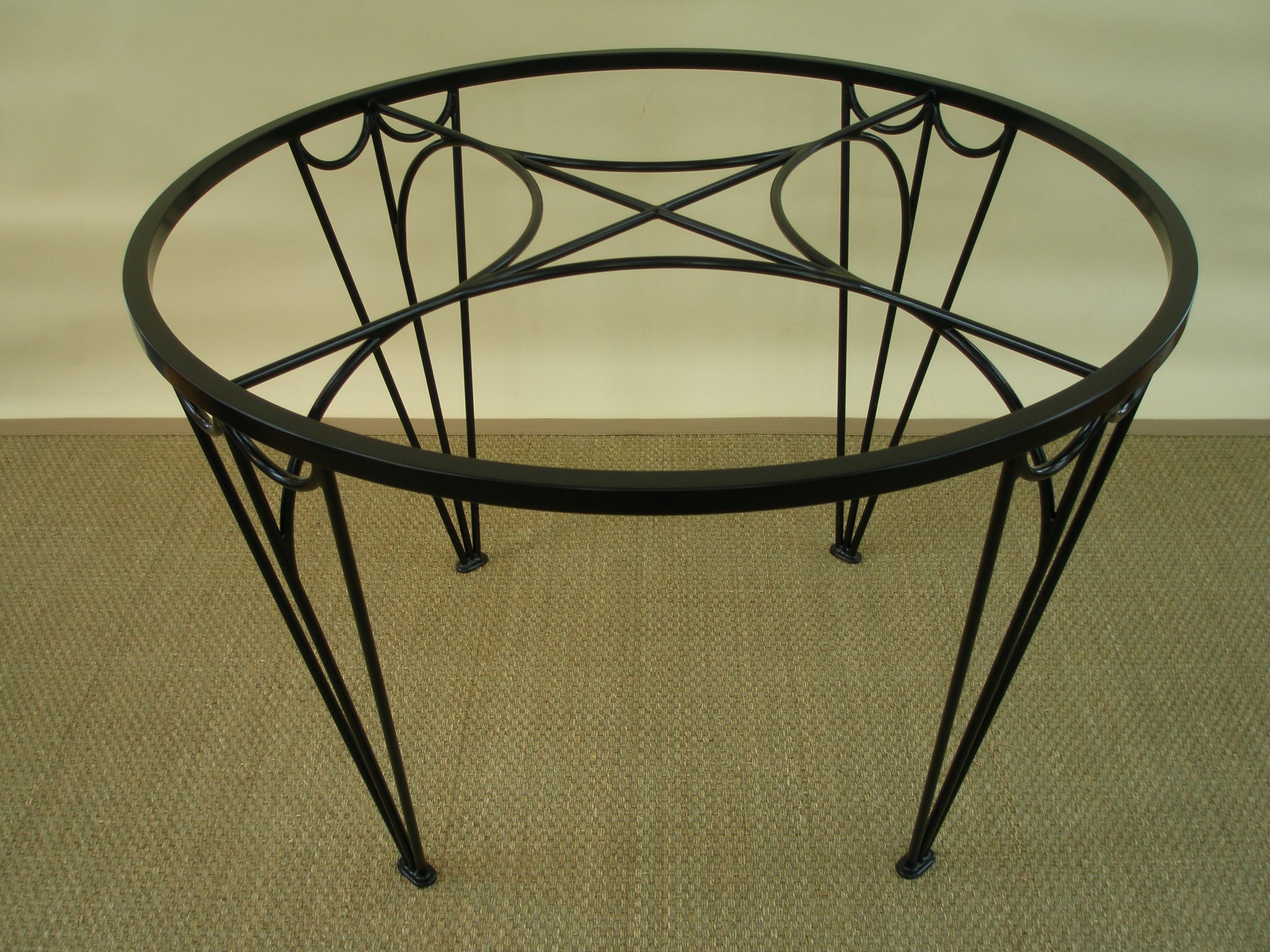









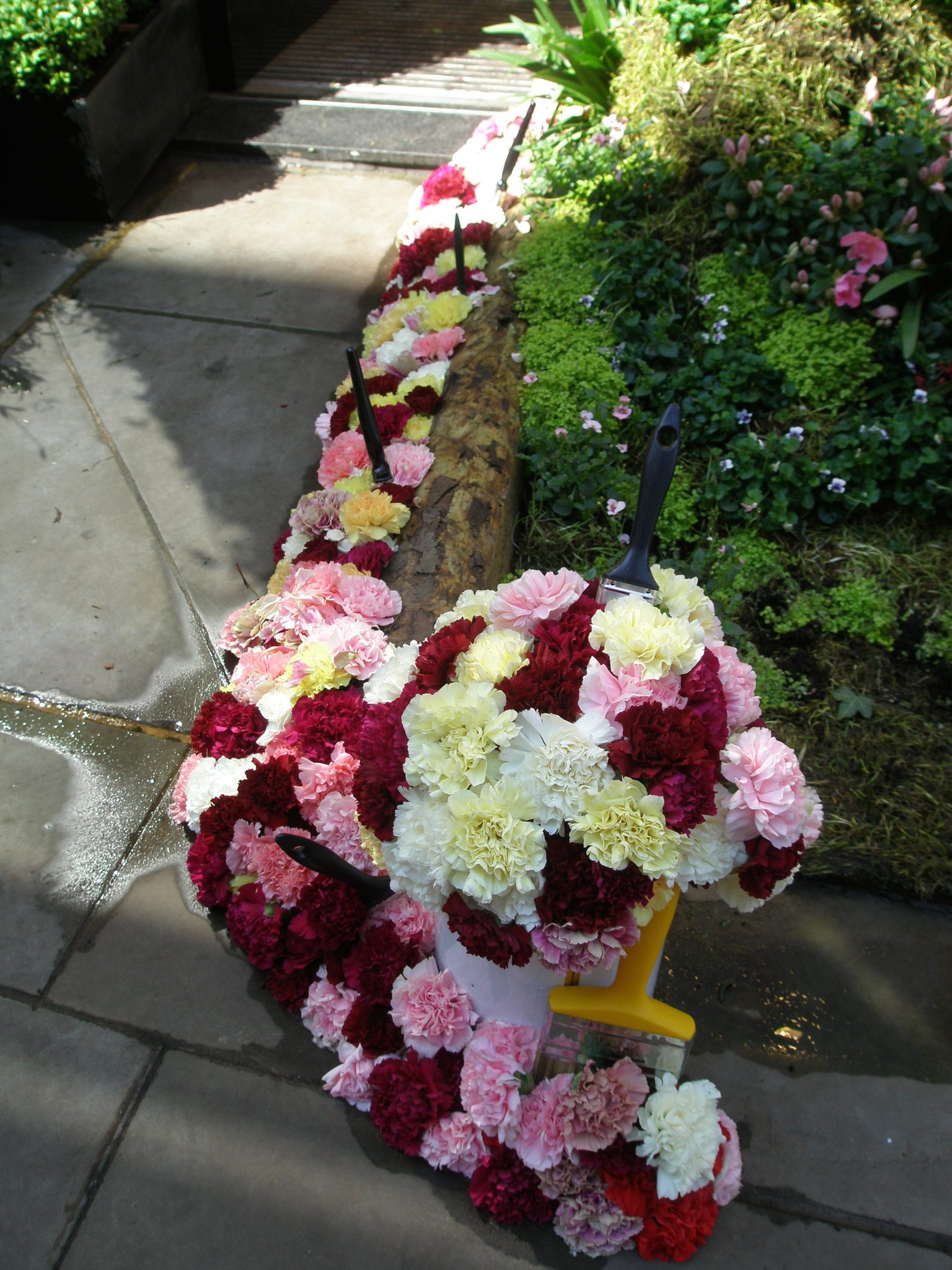








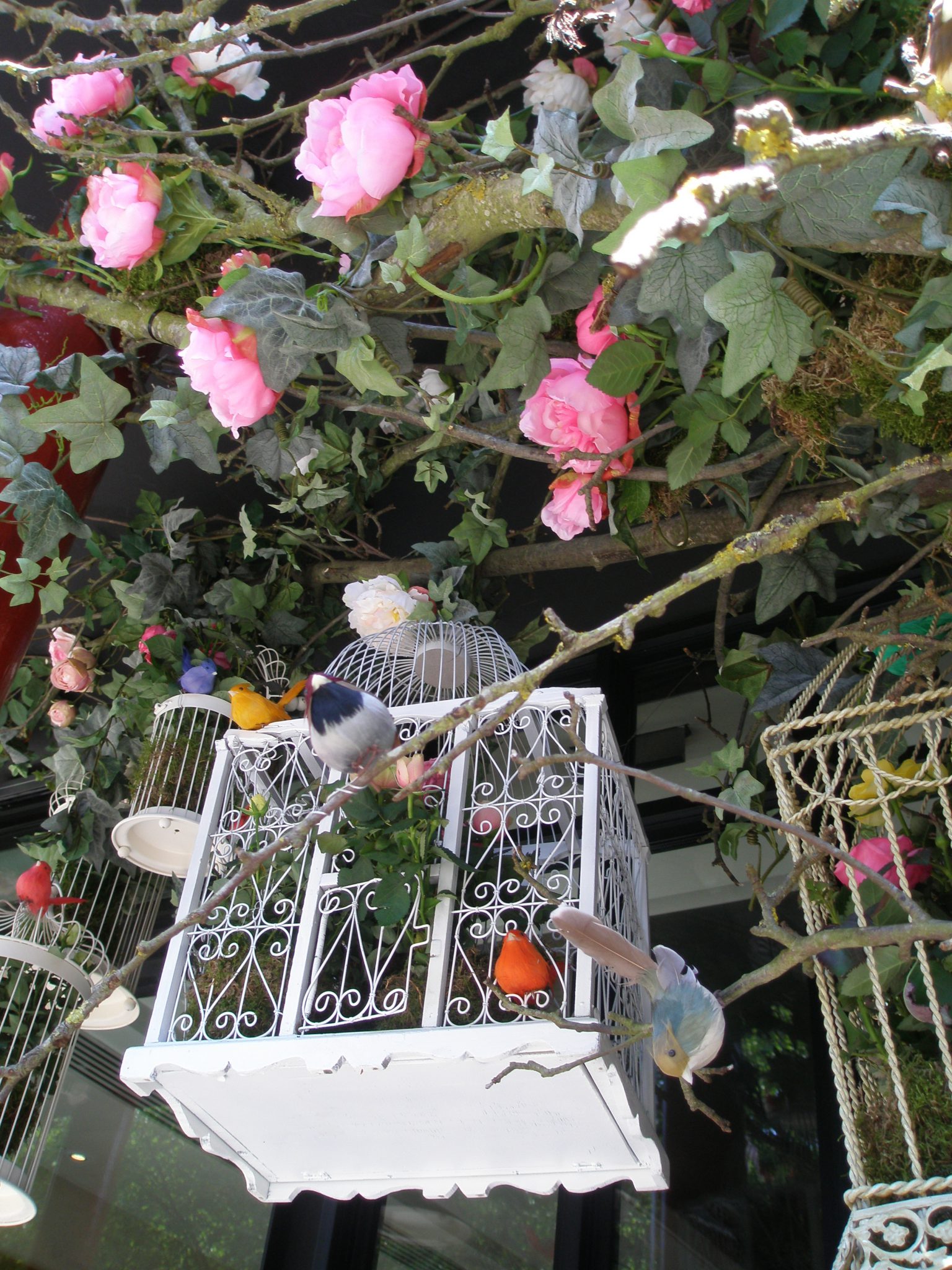




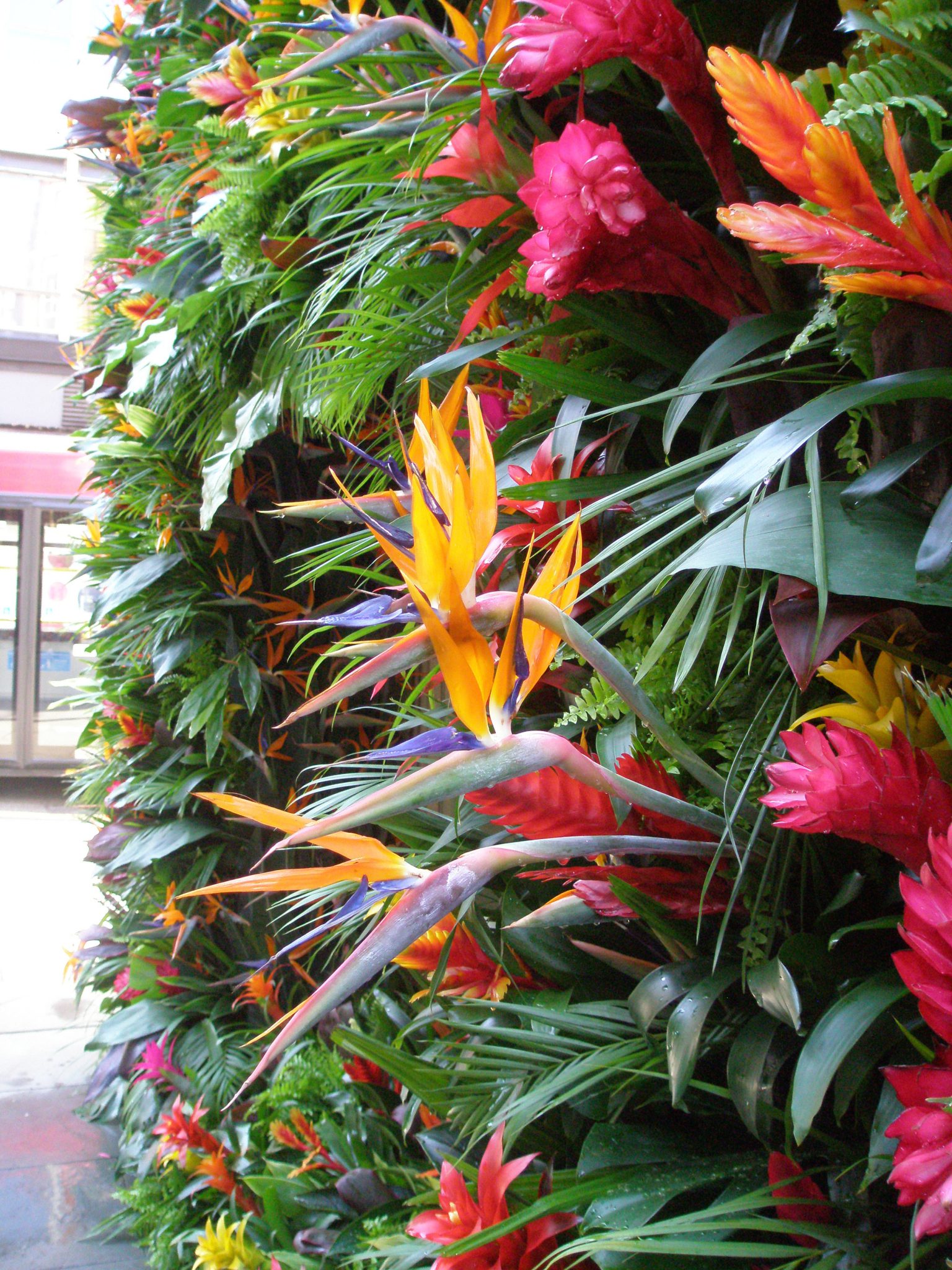















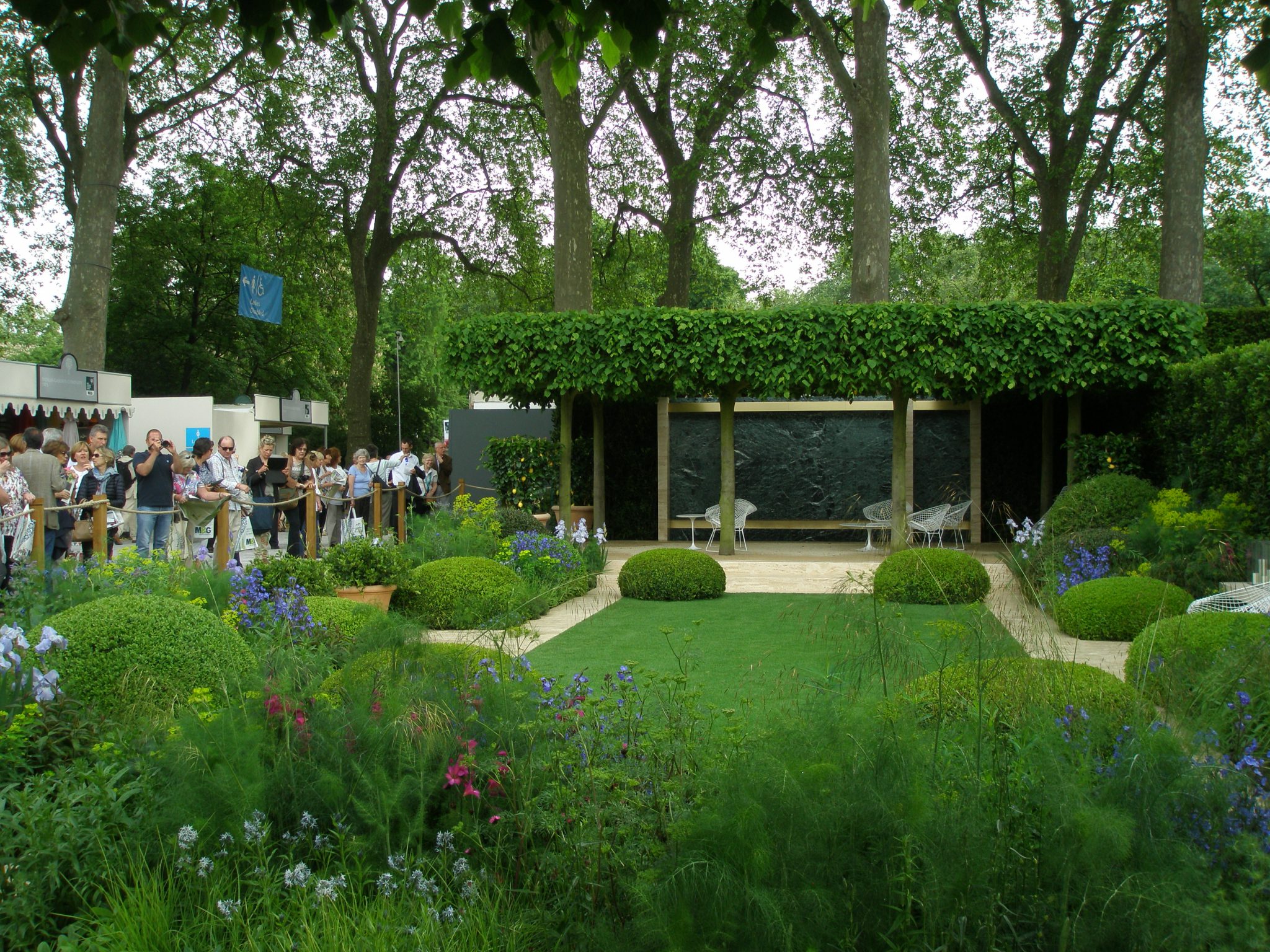



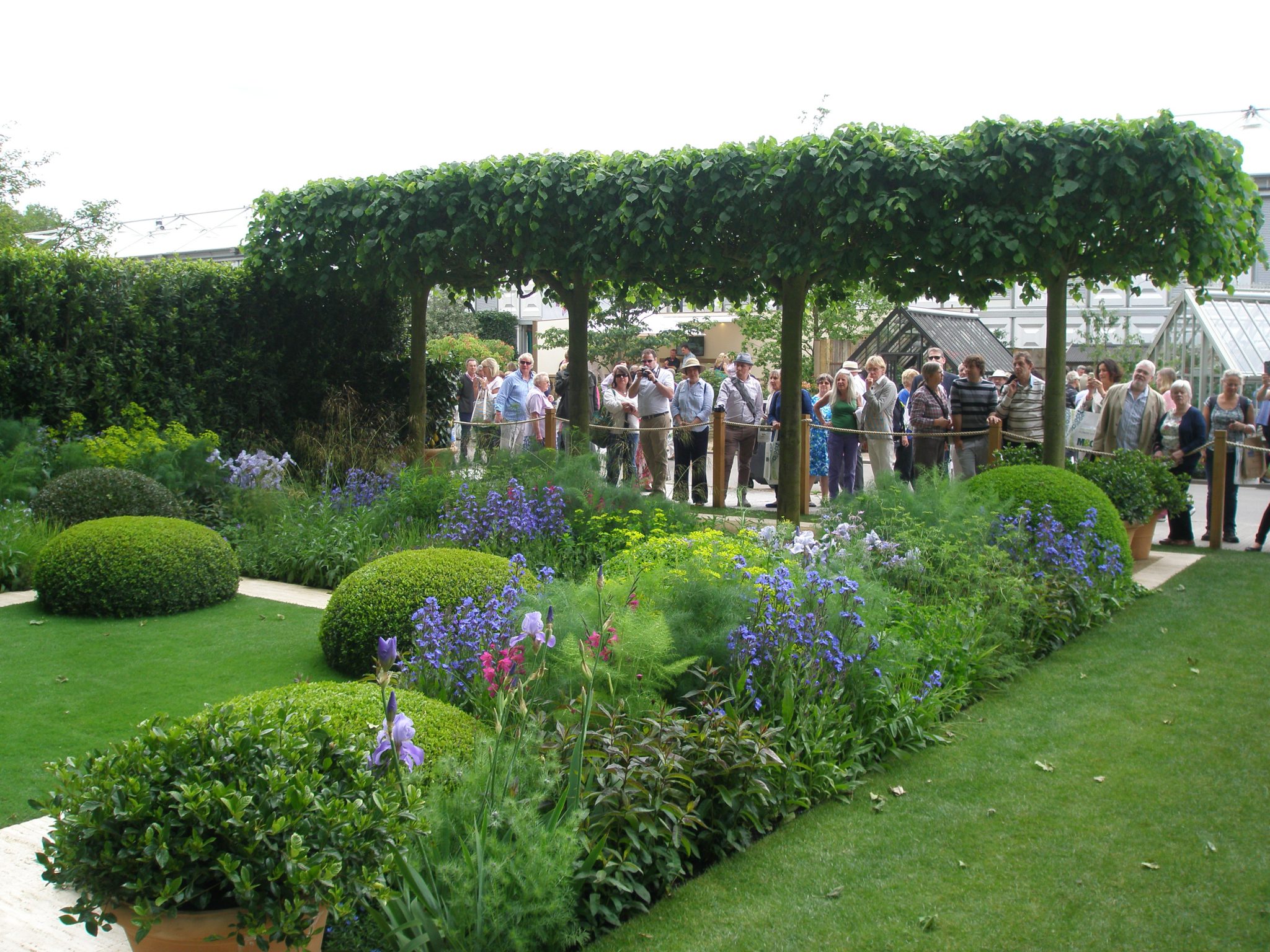












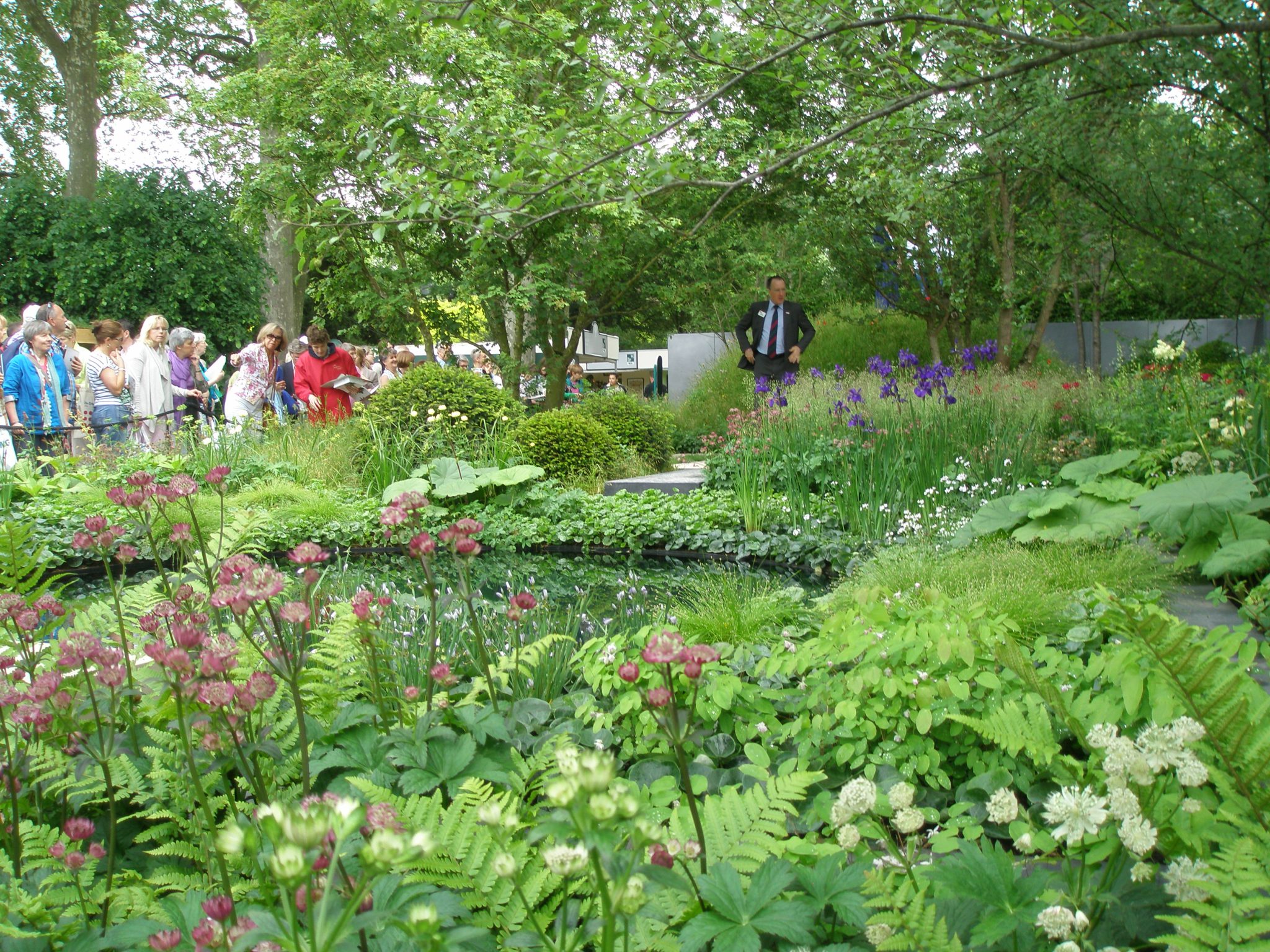





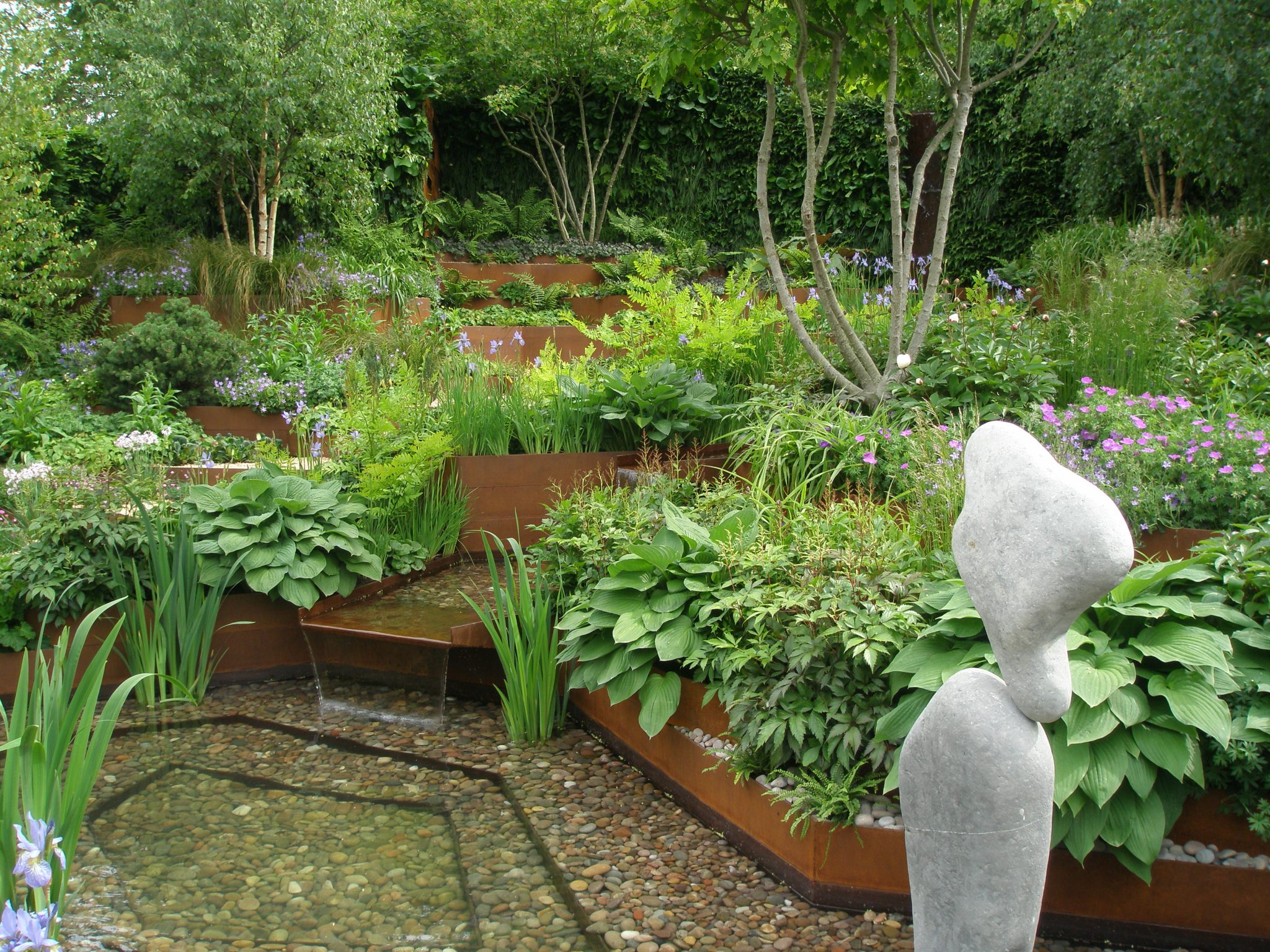



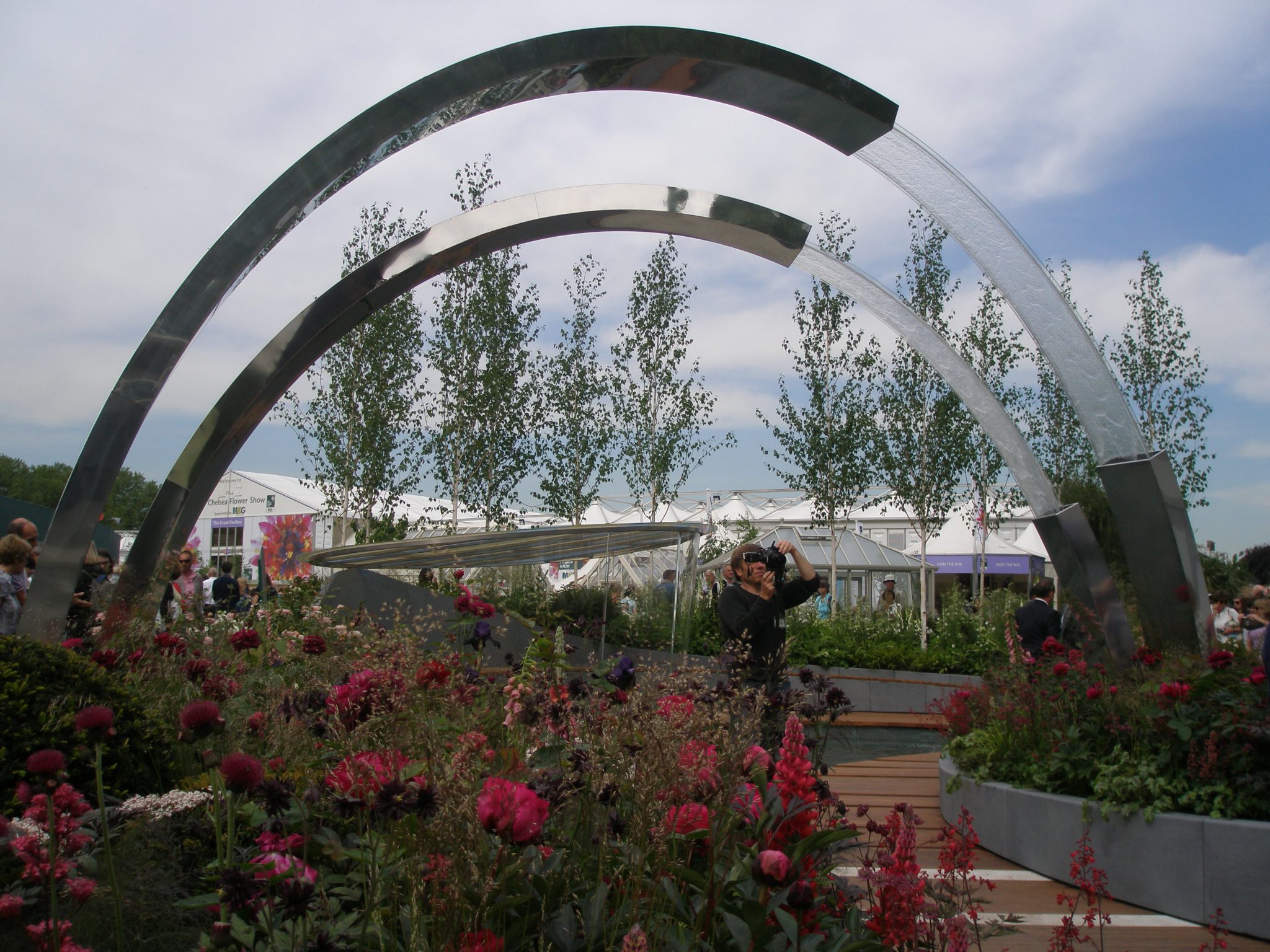


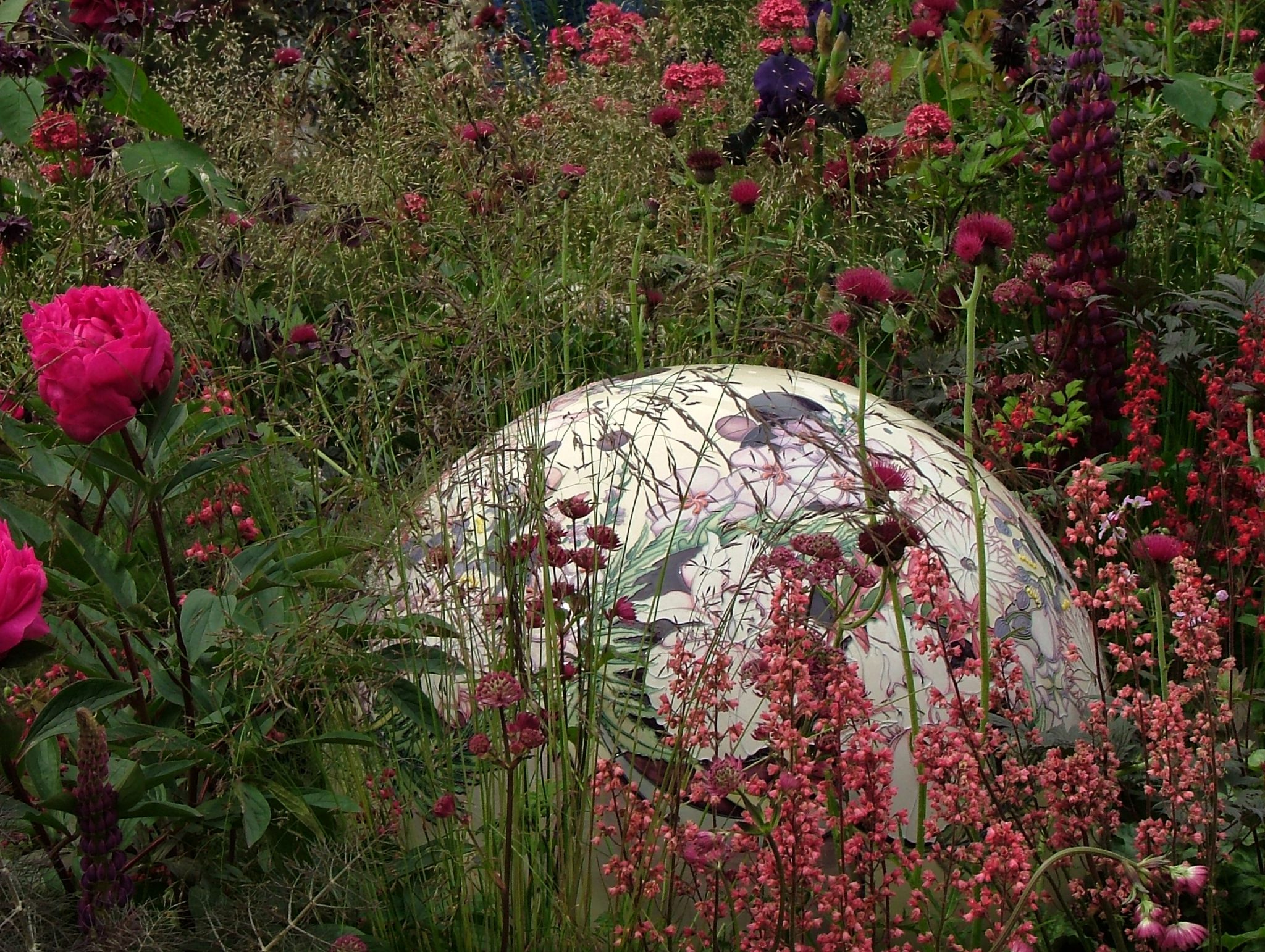


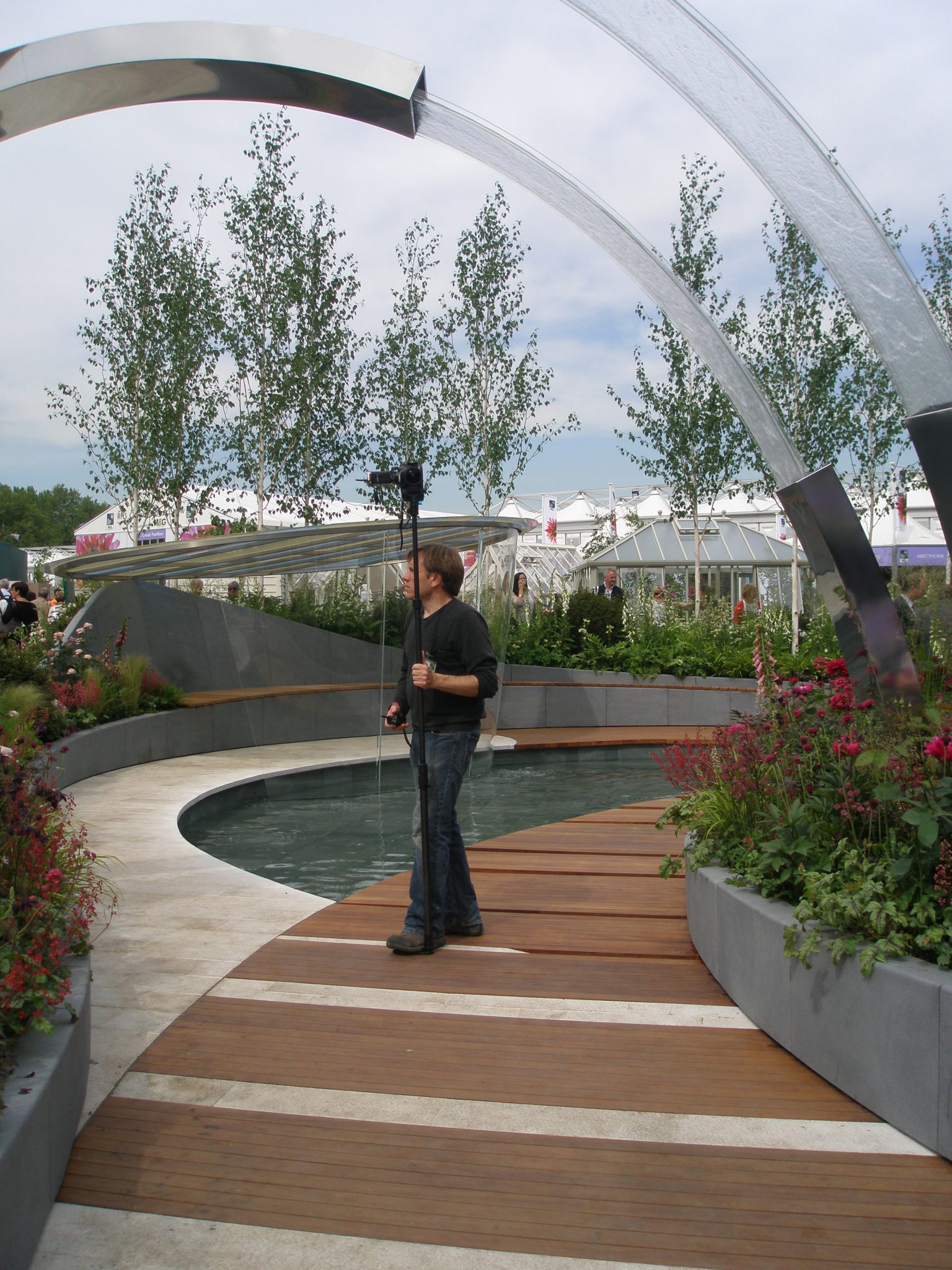

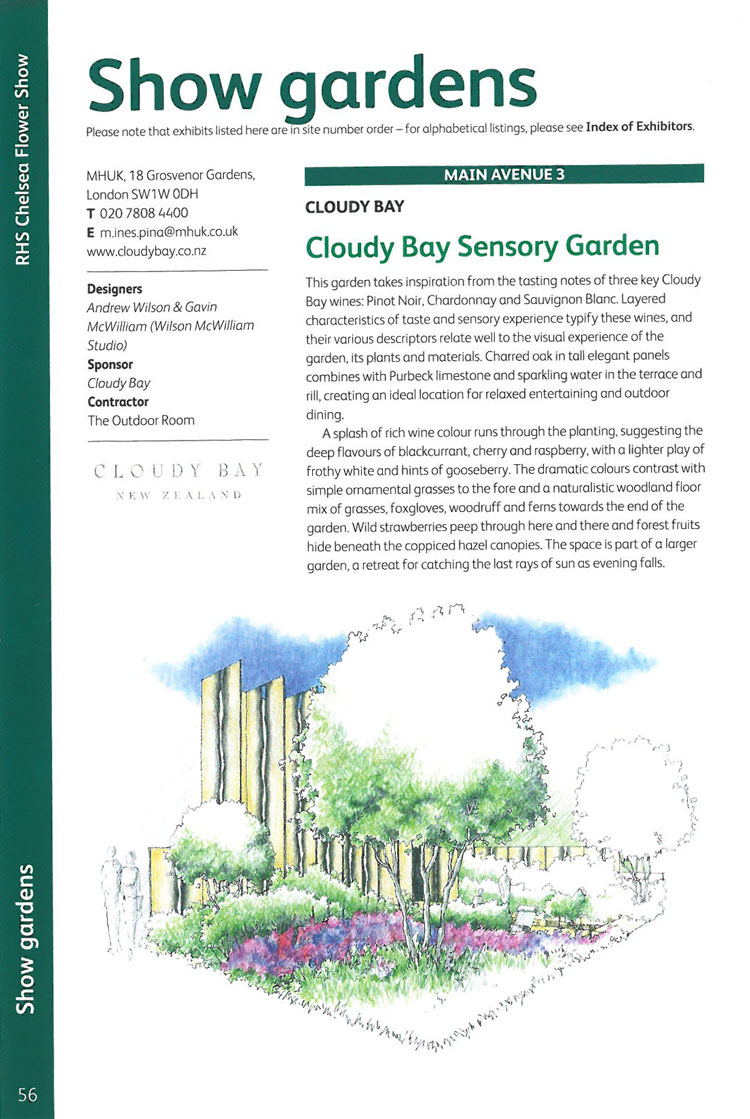

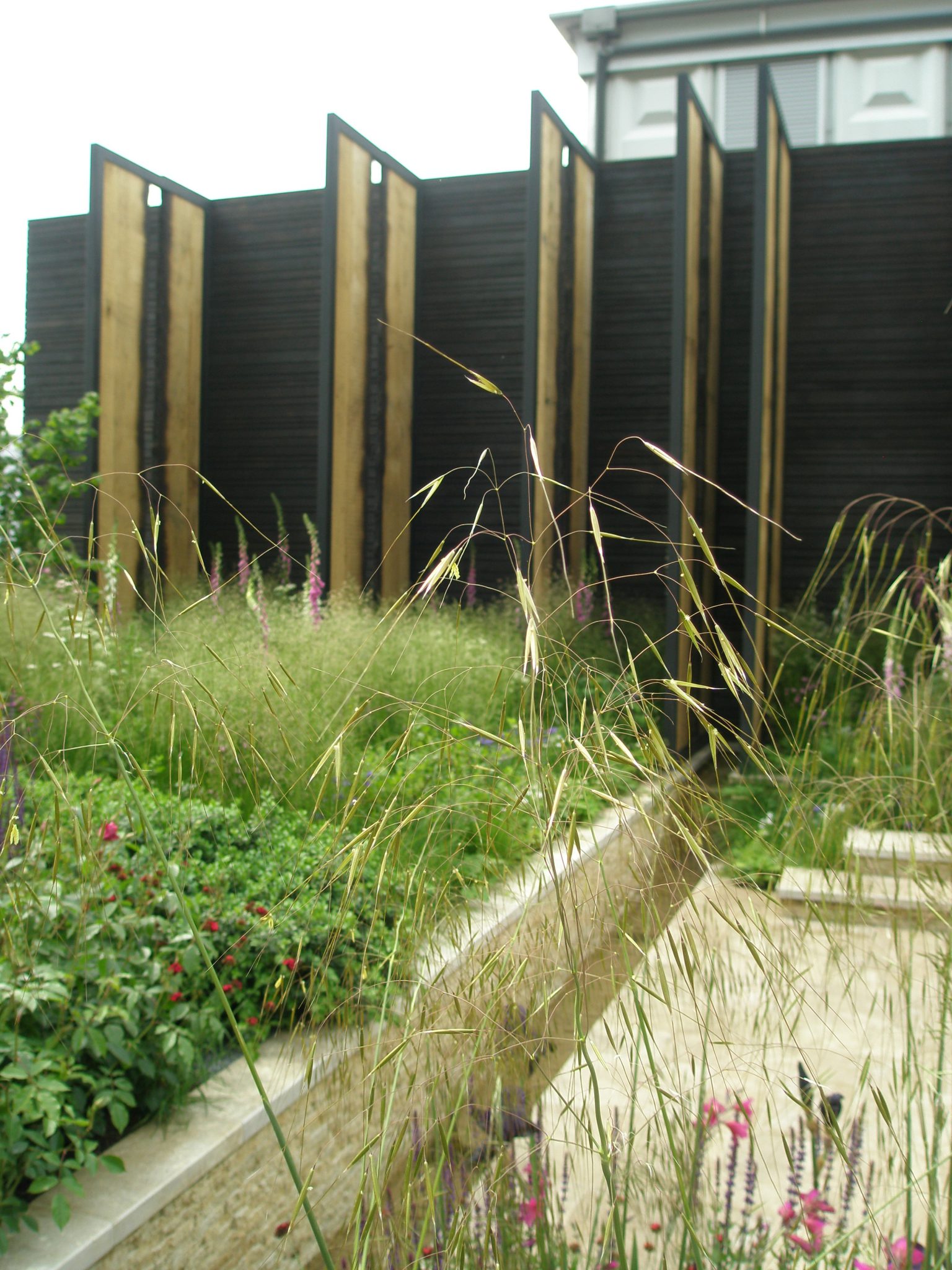








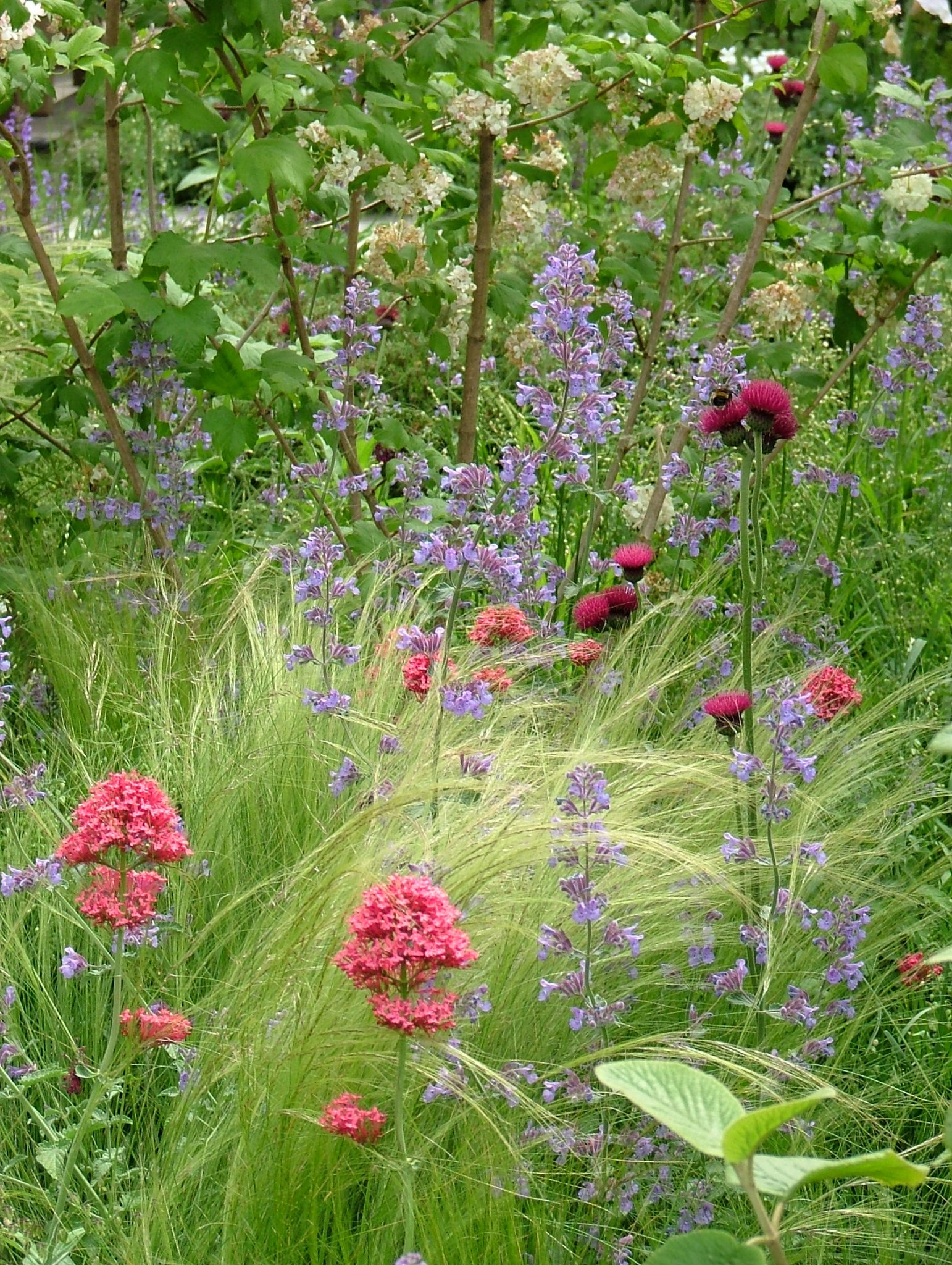








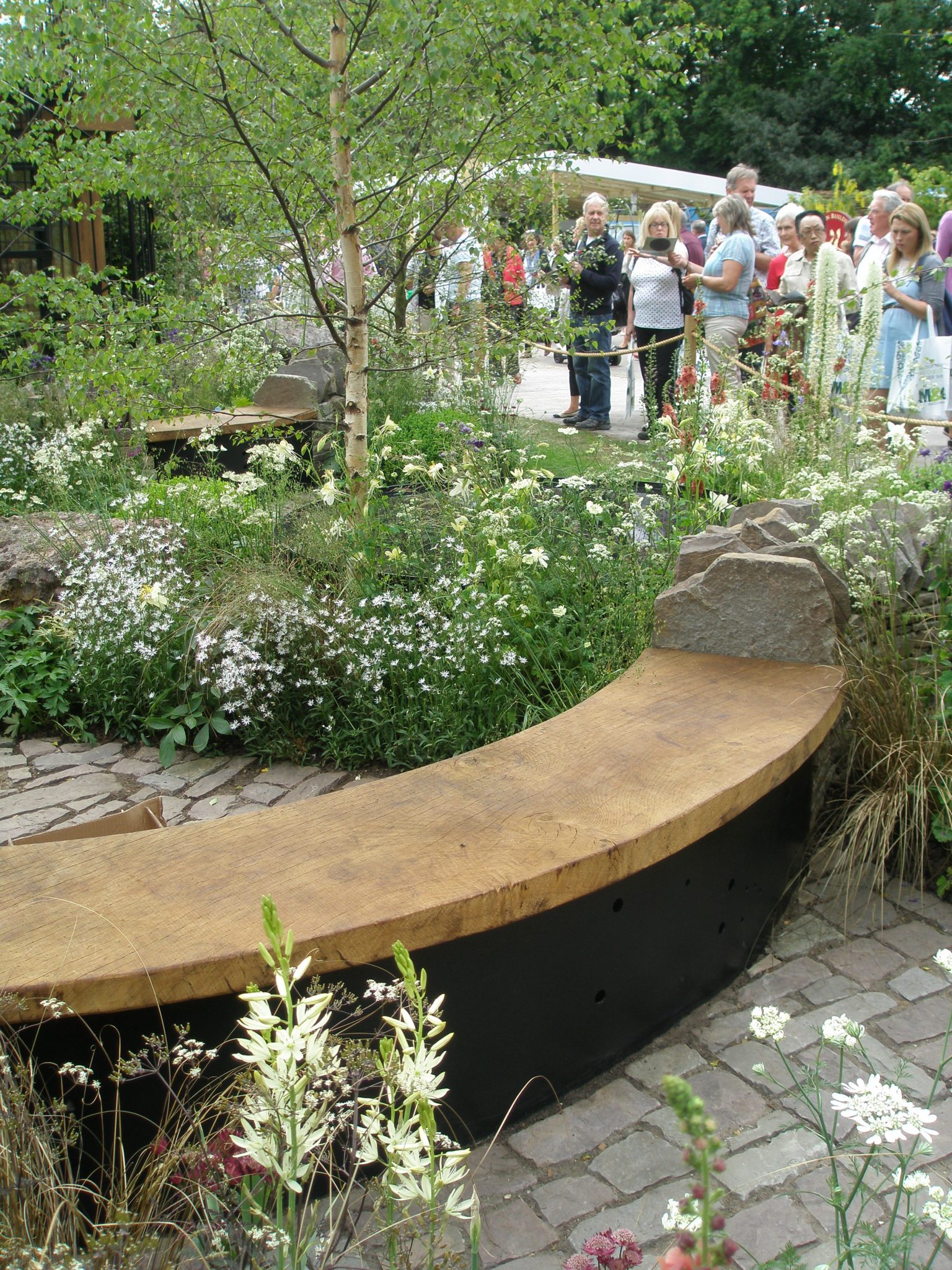


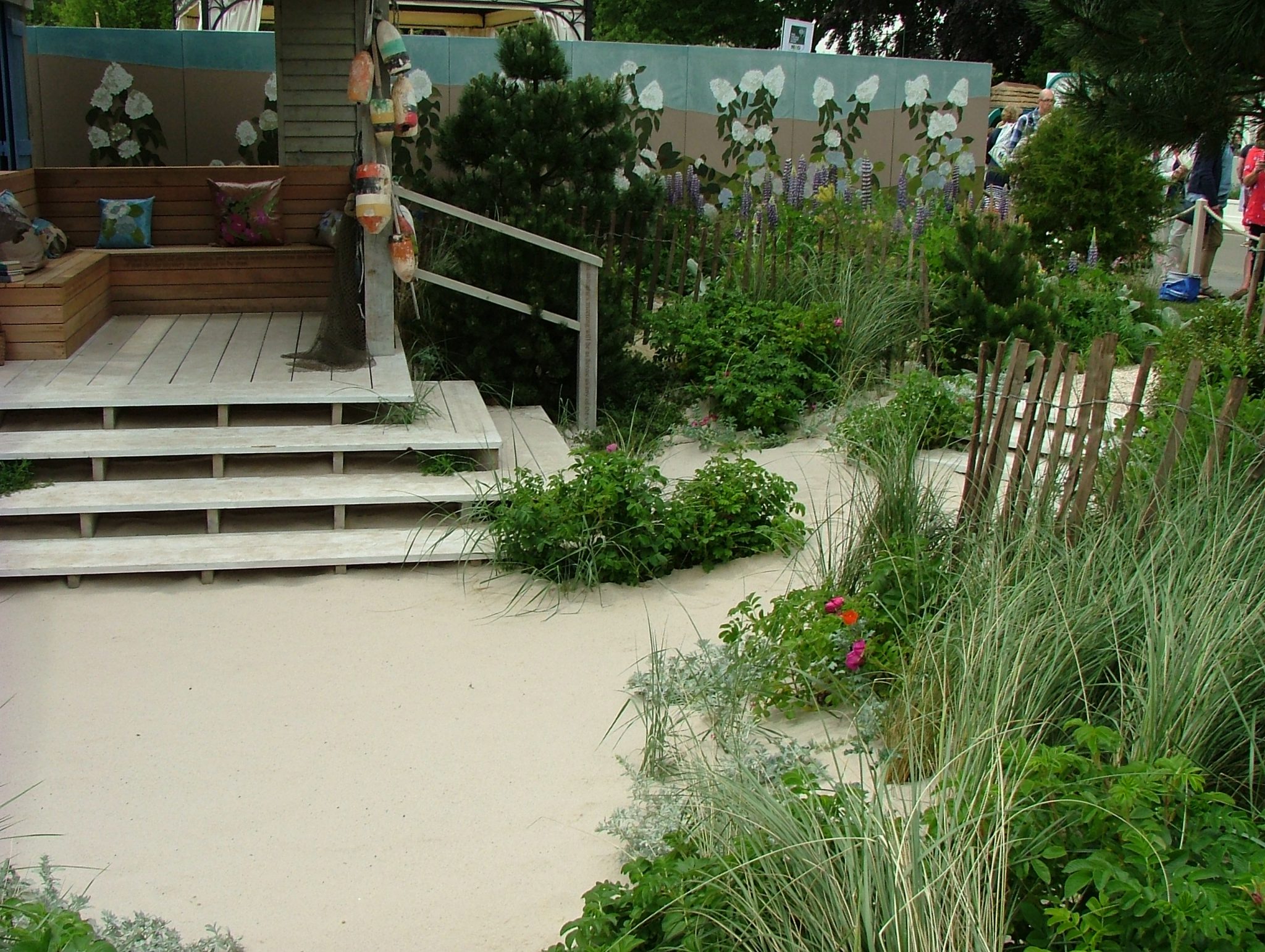











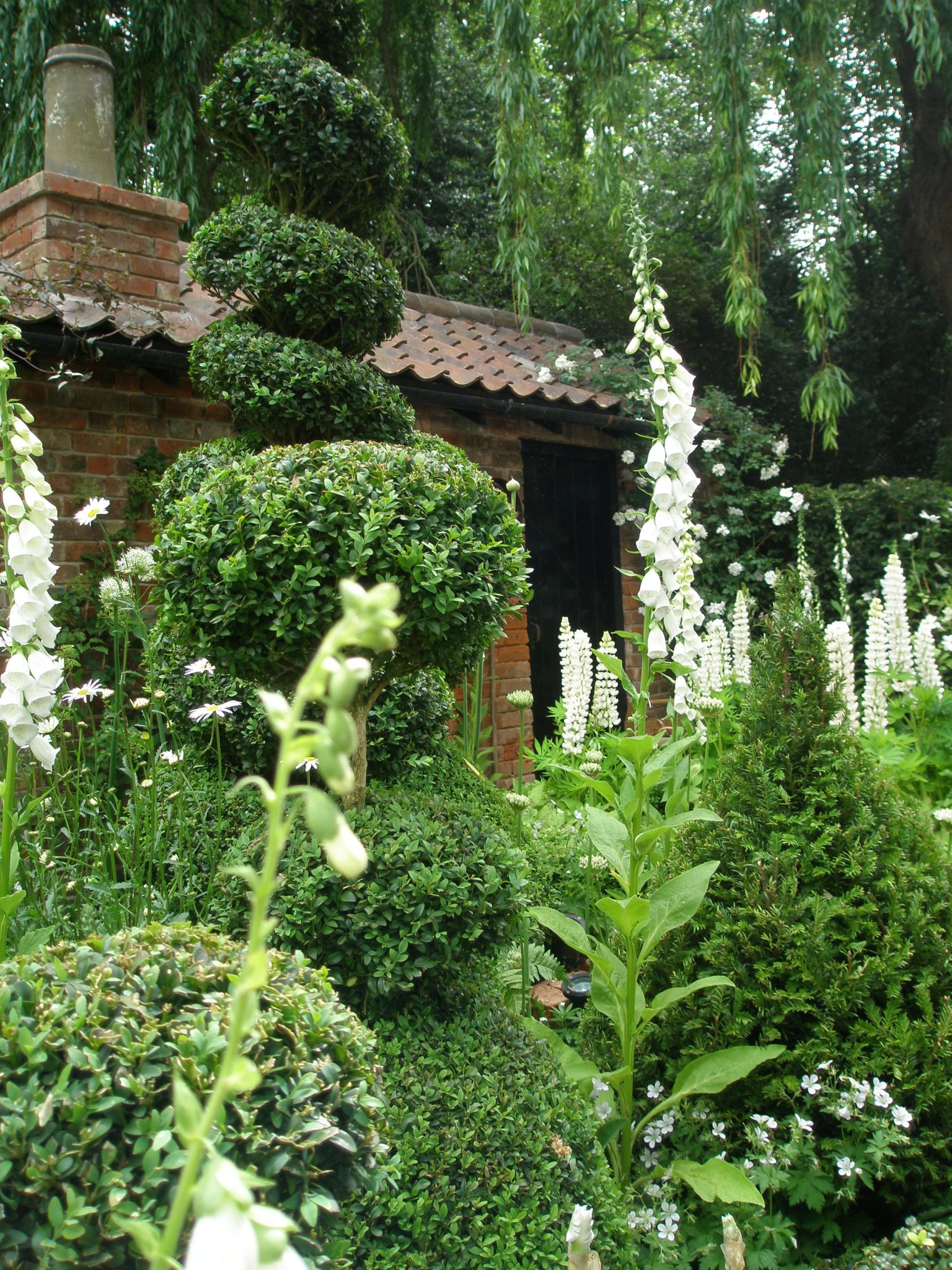



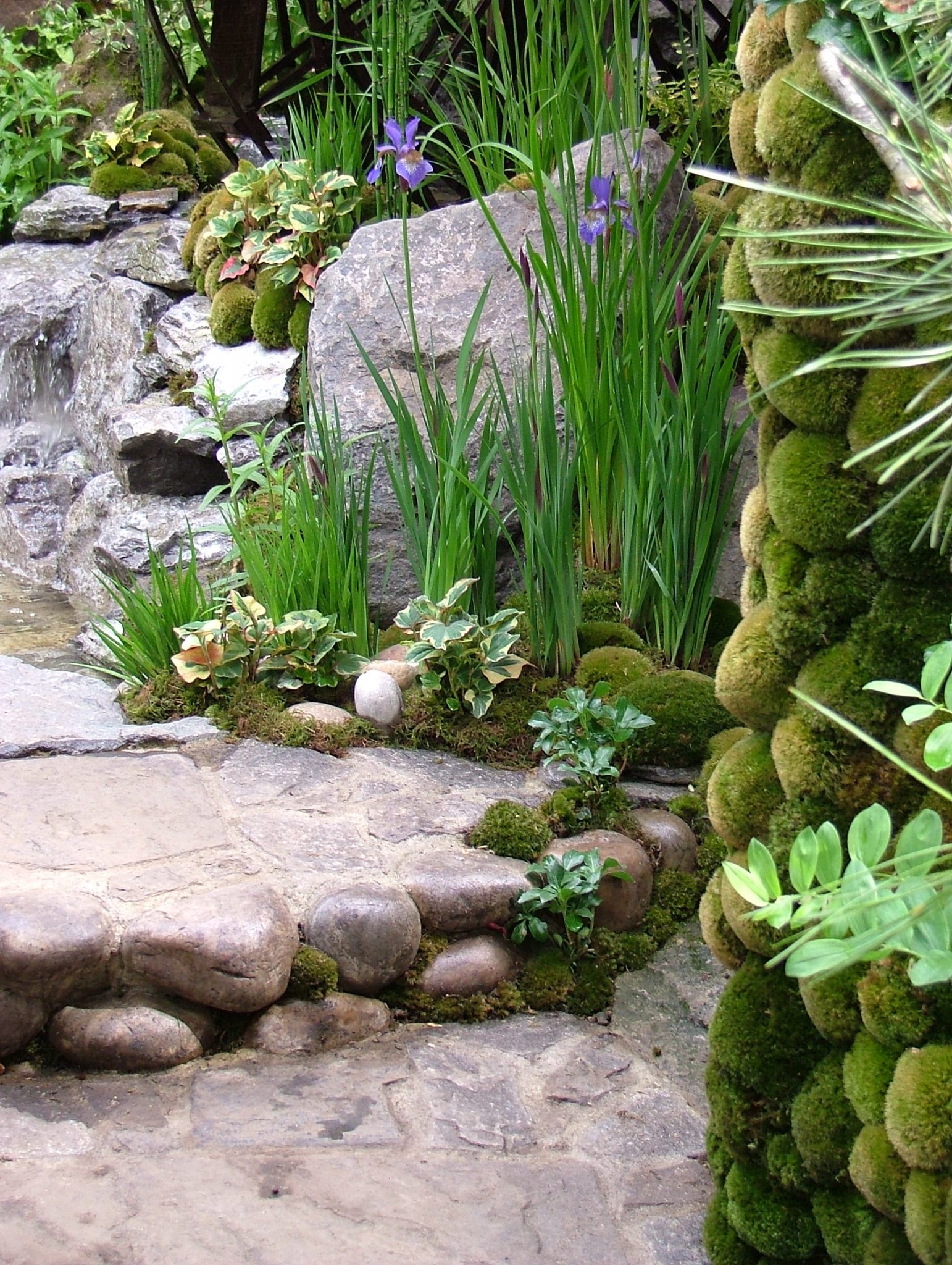






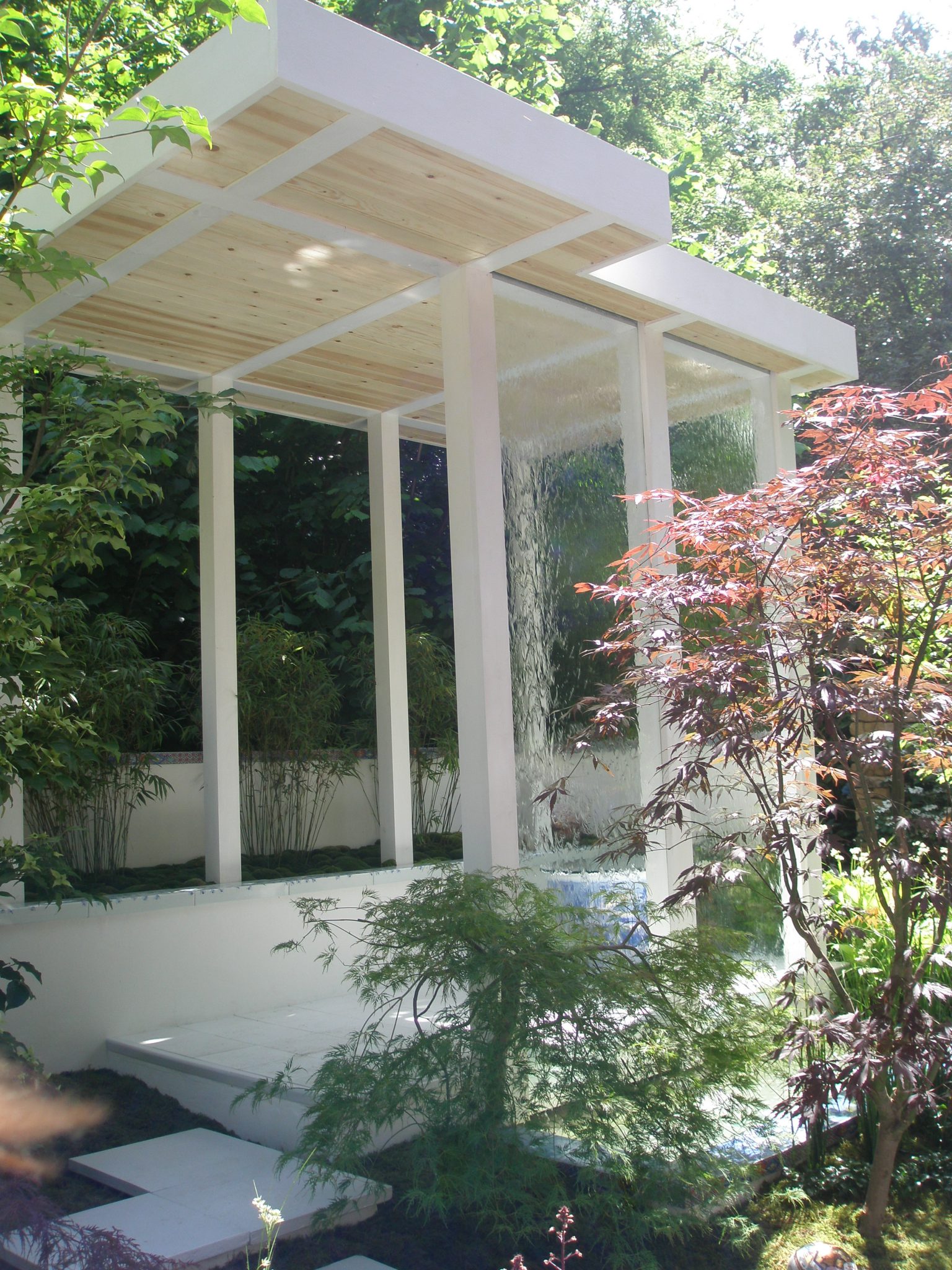

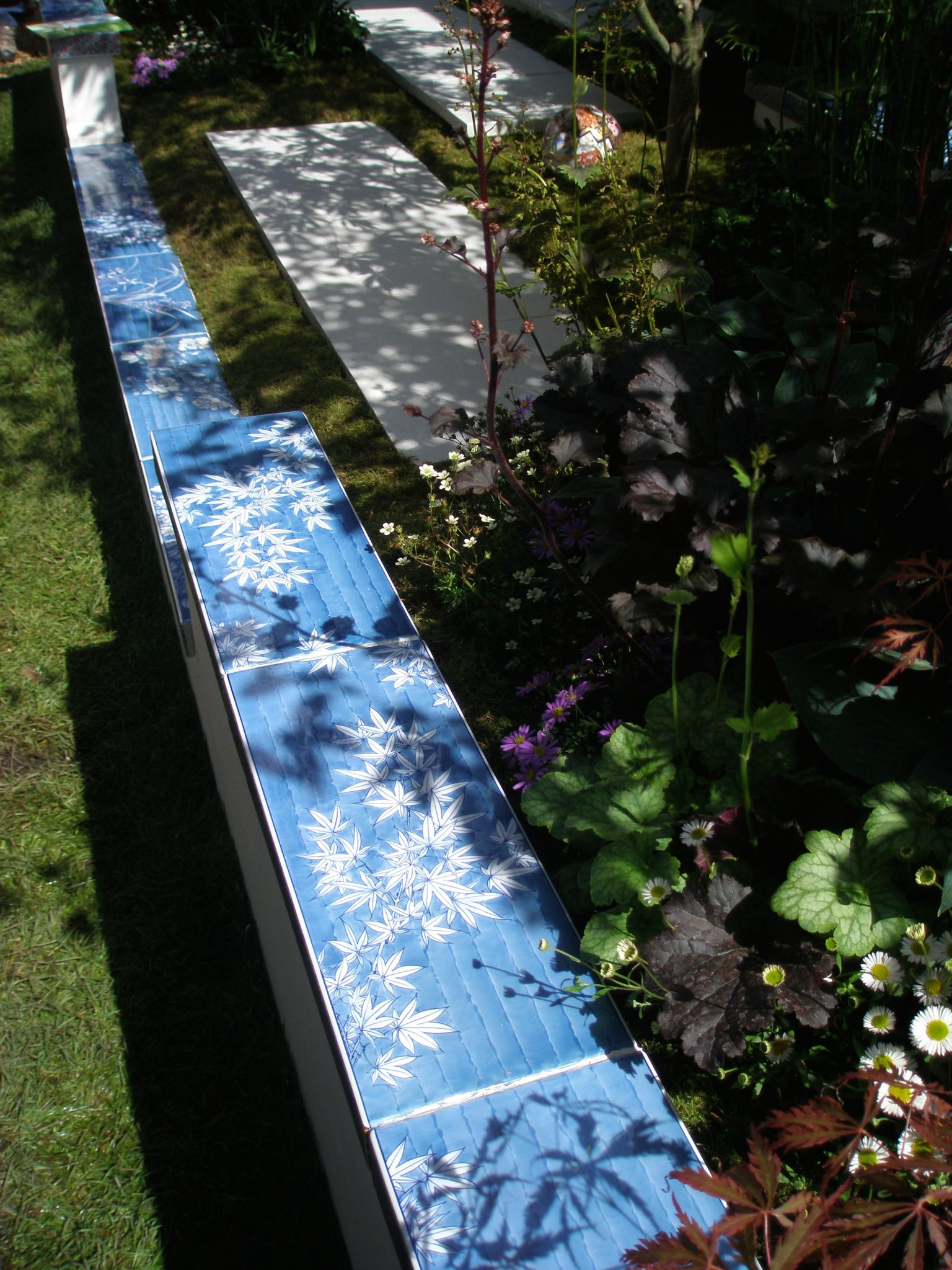


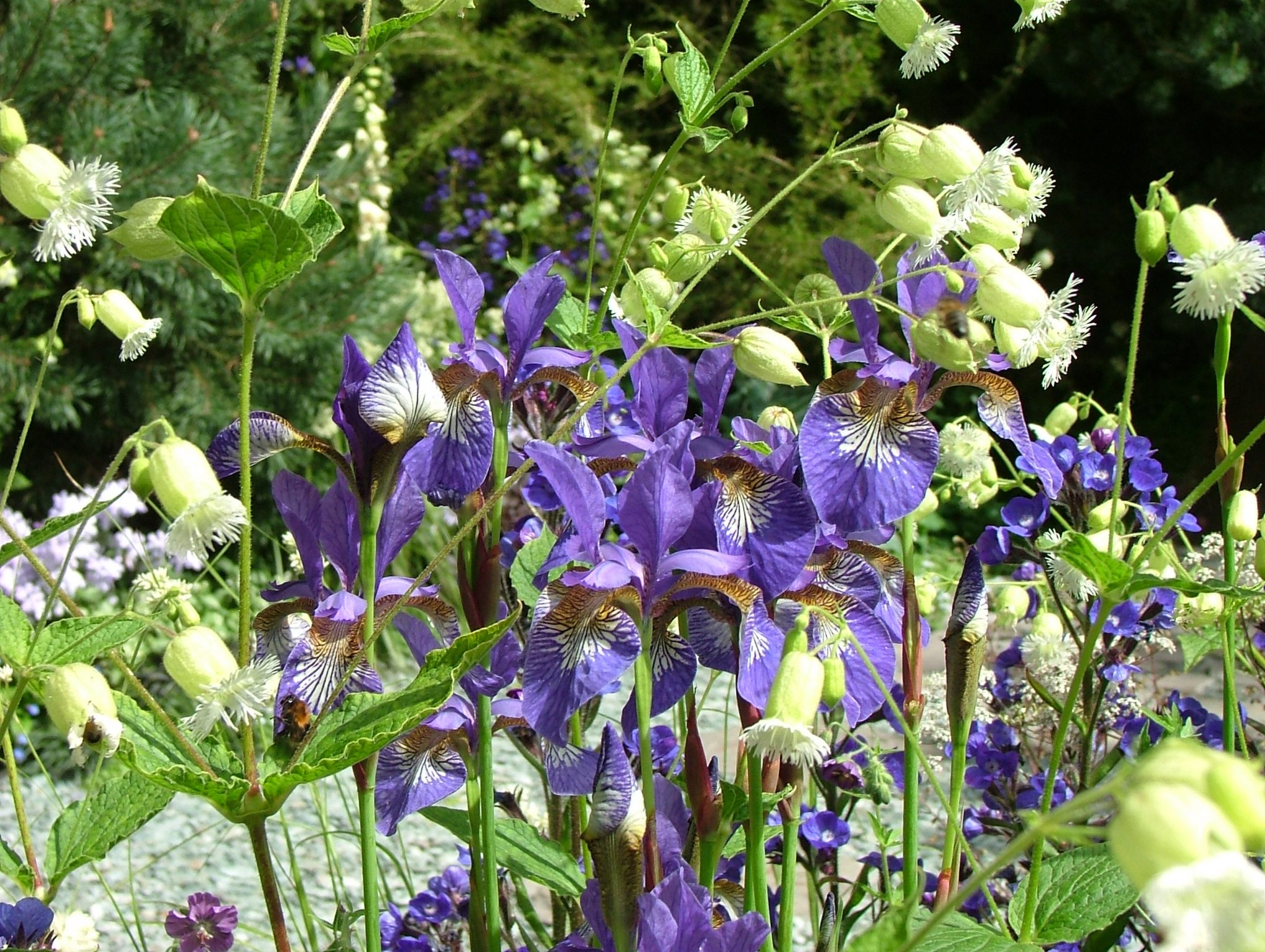






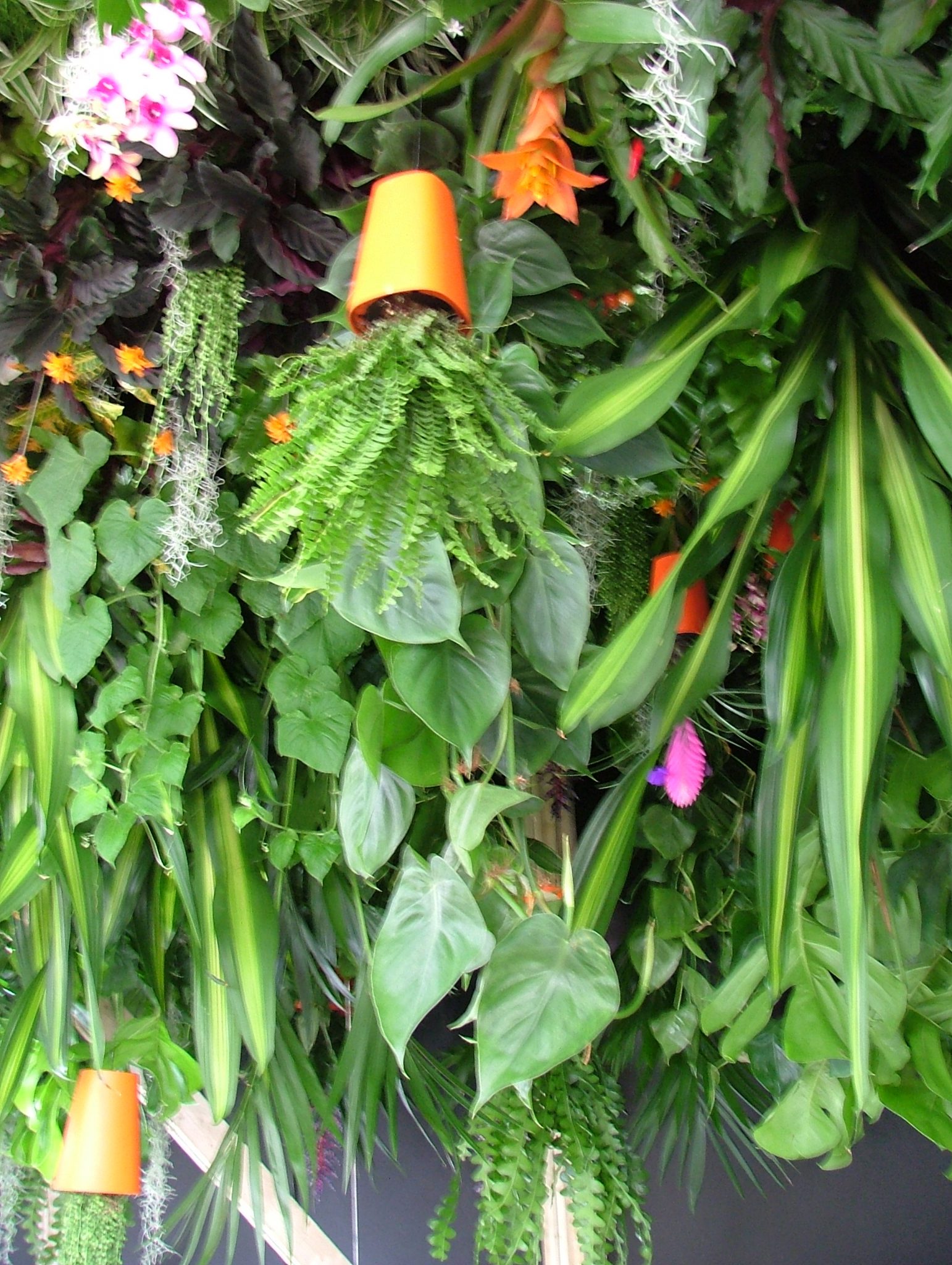



























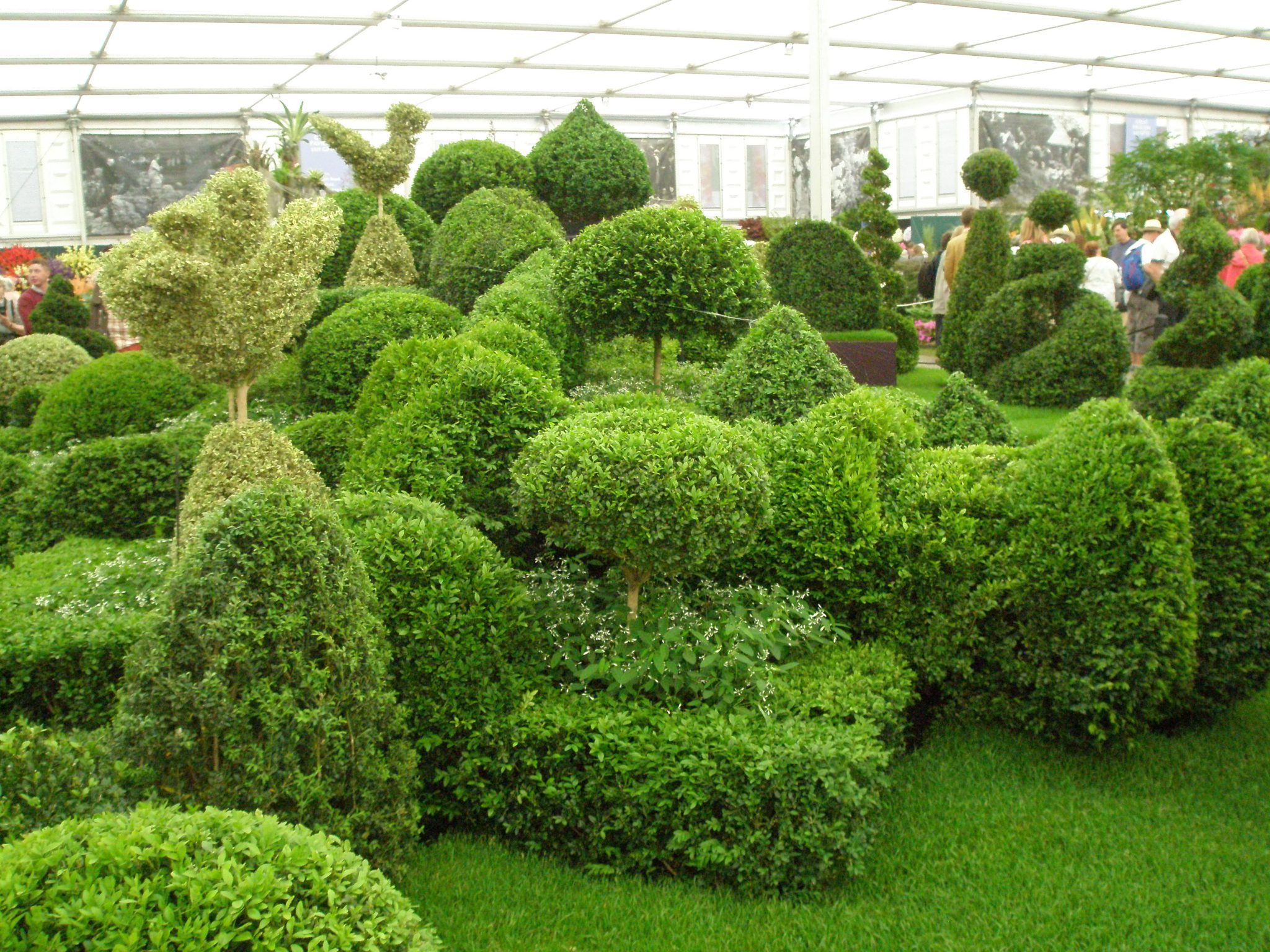
































3 Responses to The Chelsea Flower Show of 2014: Contemplating the Biggest Pop-Up Gardens in the World.